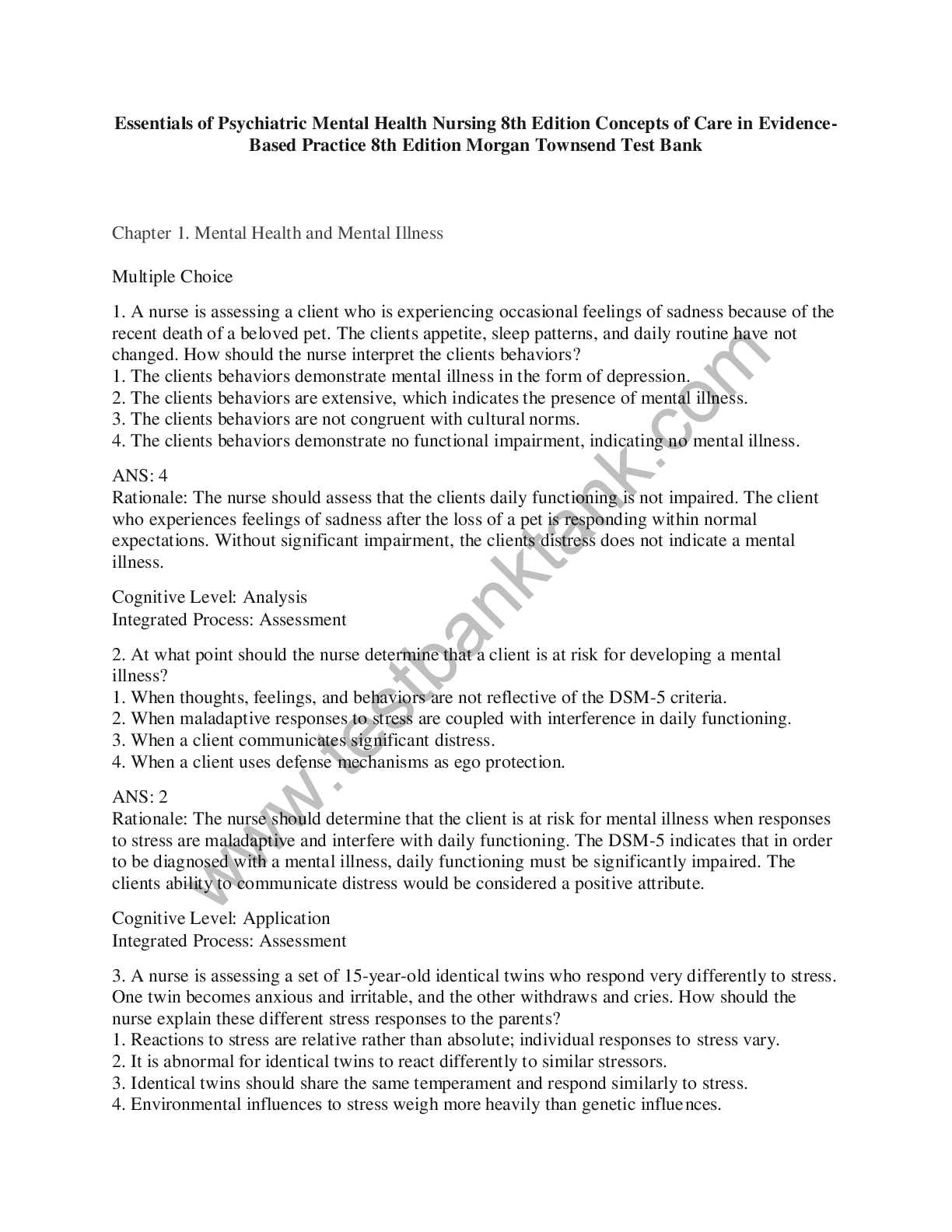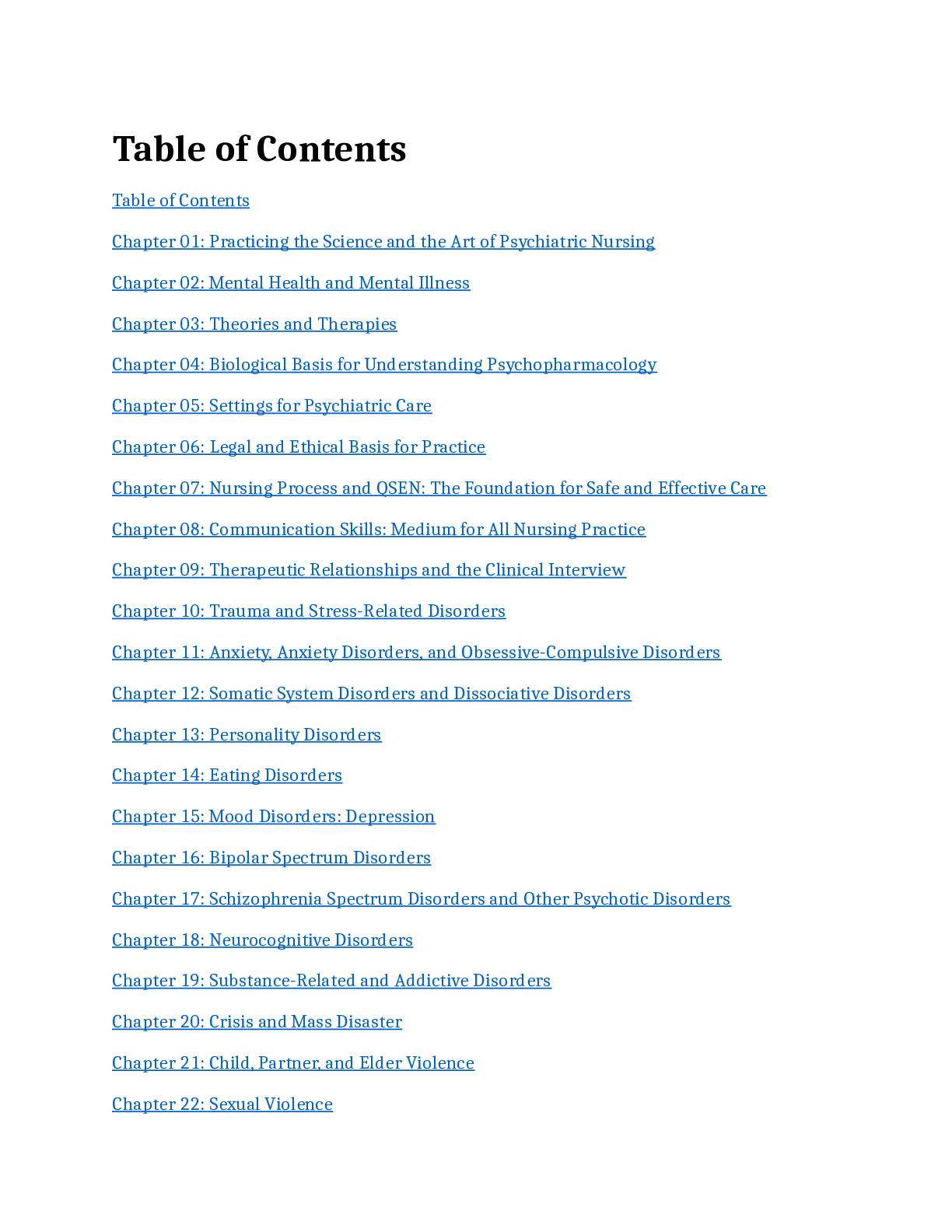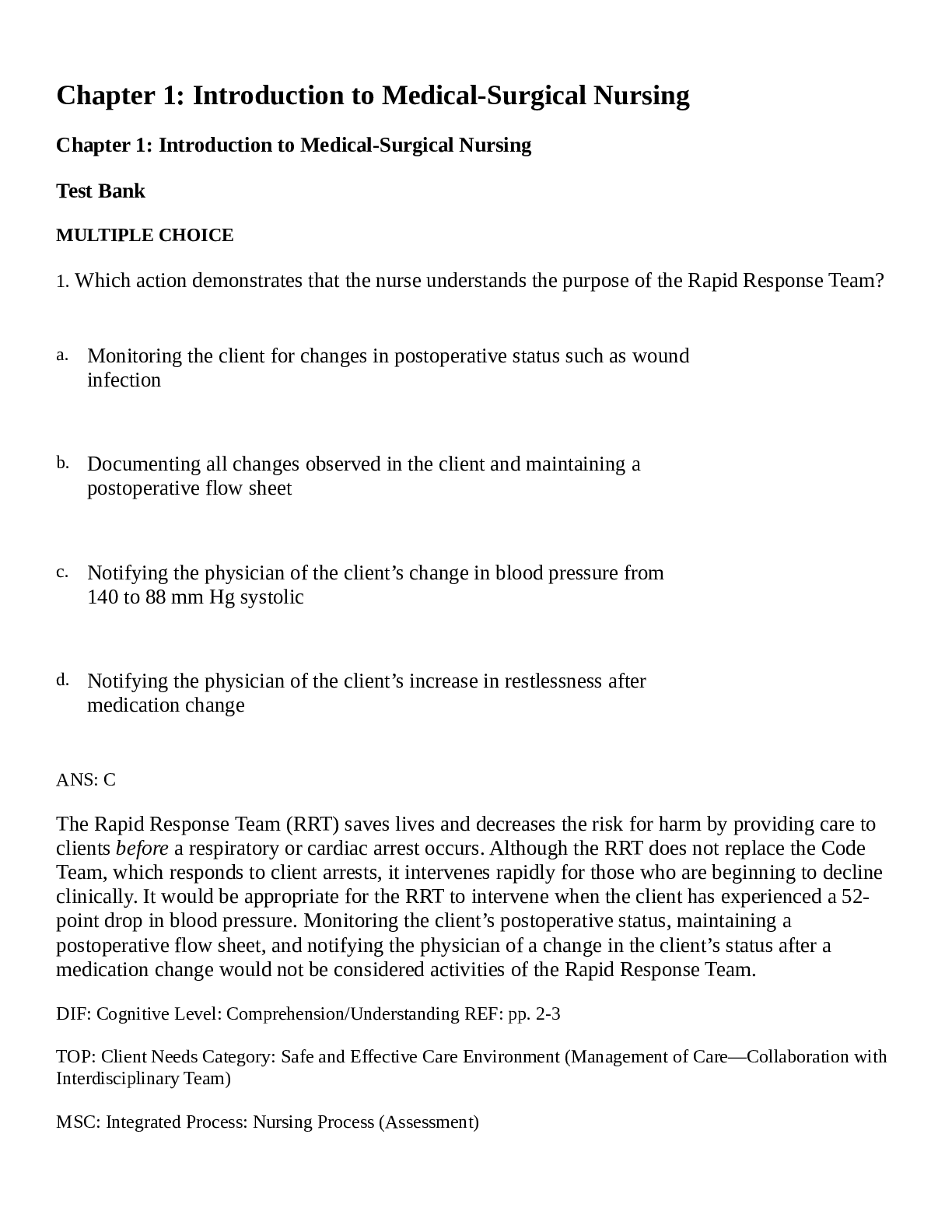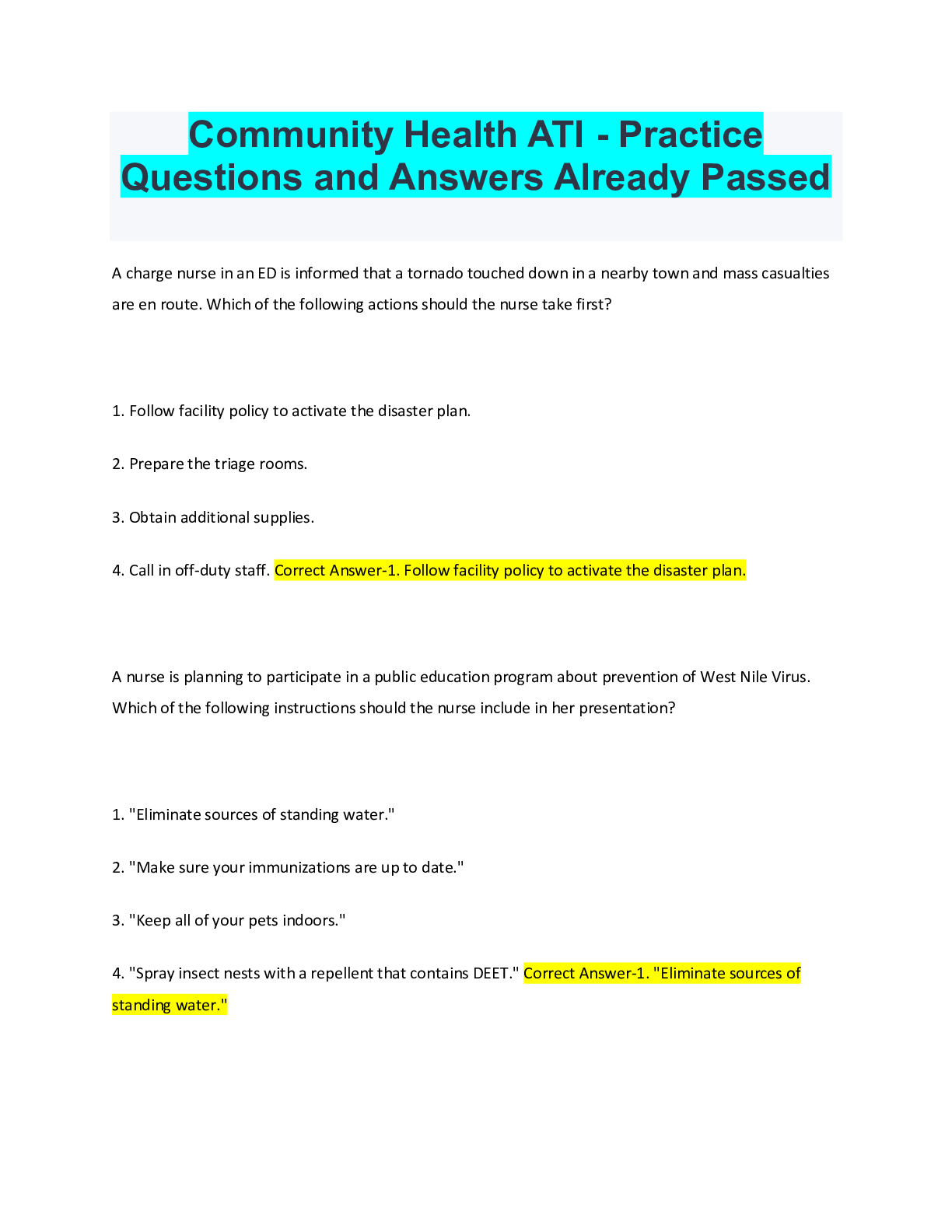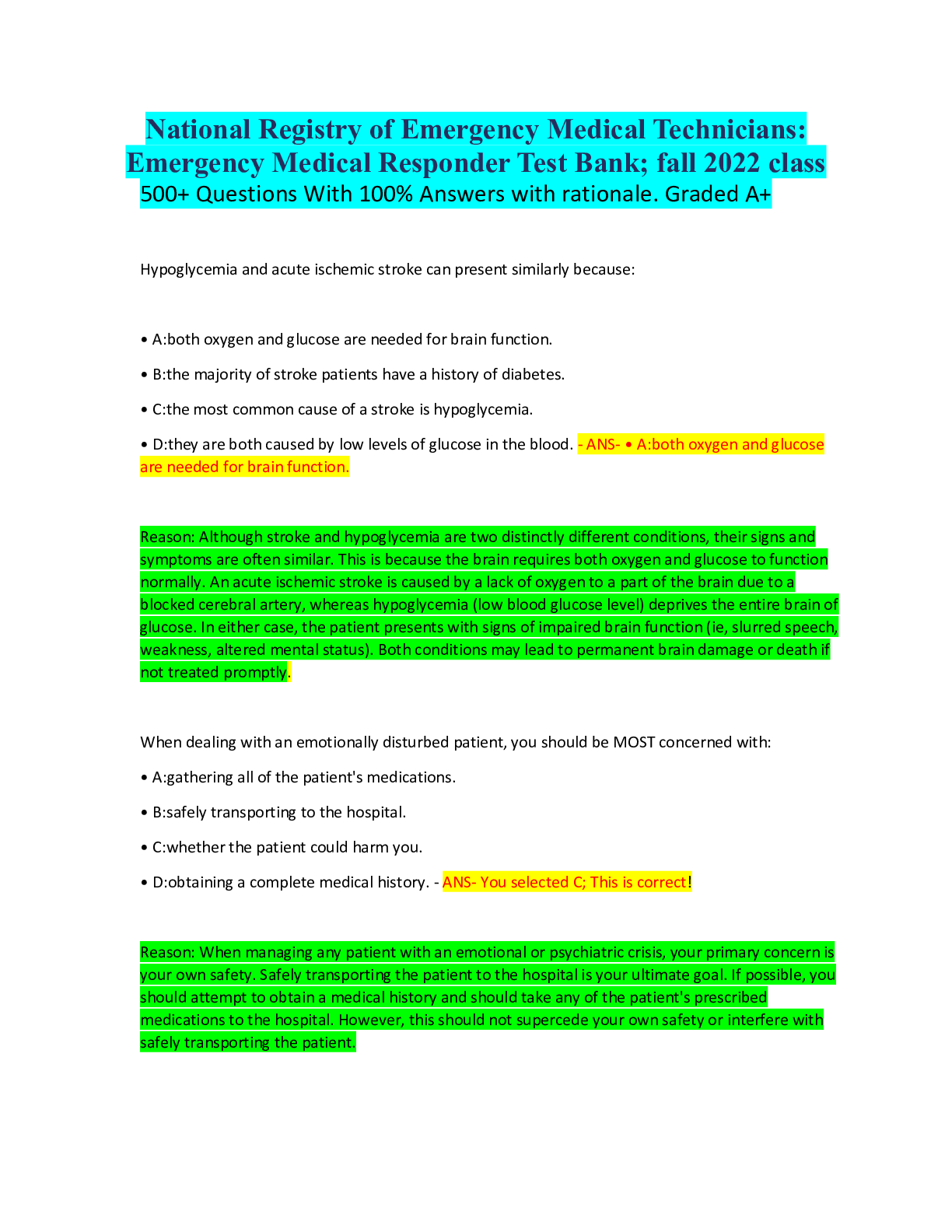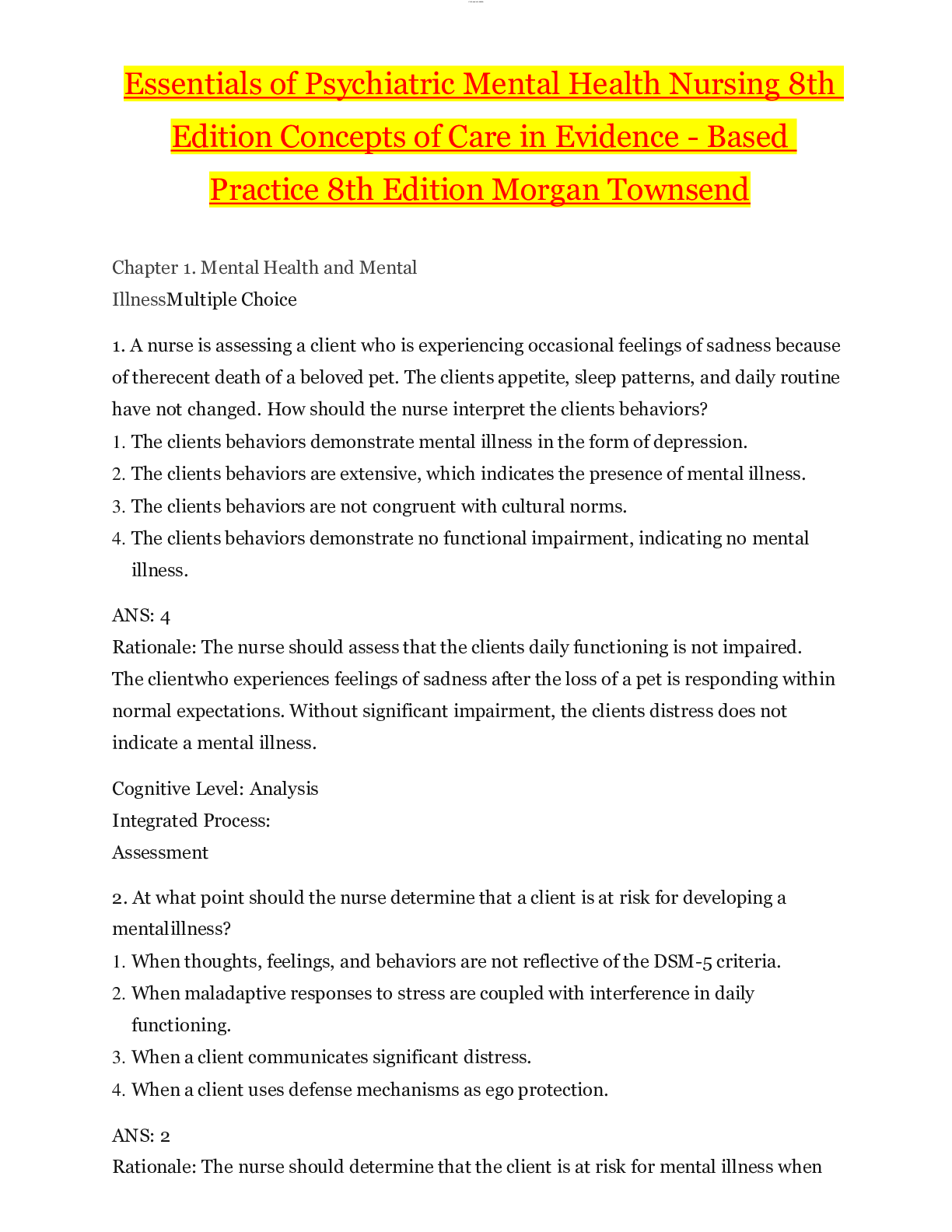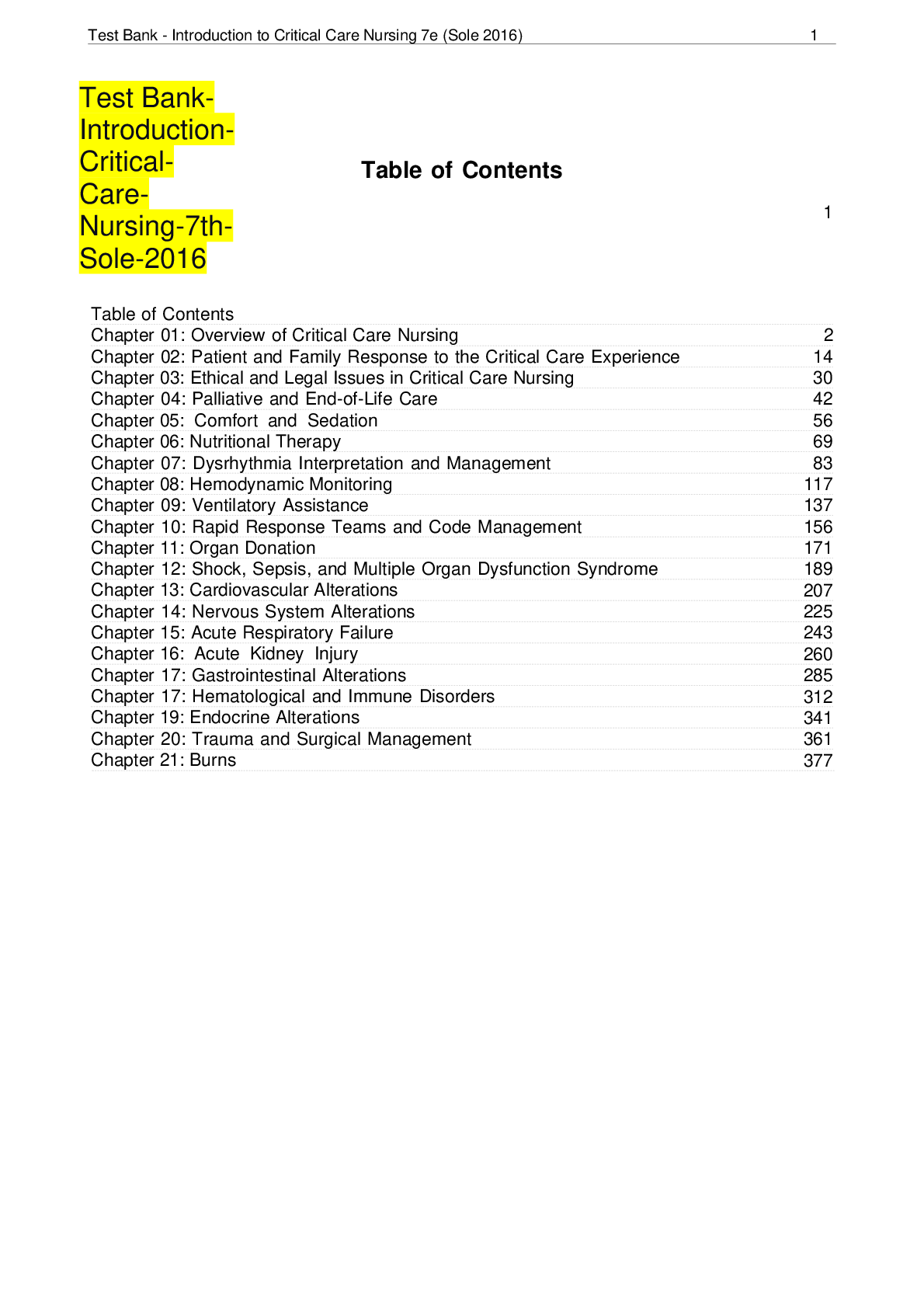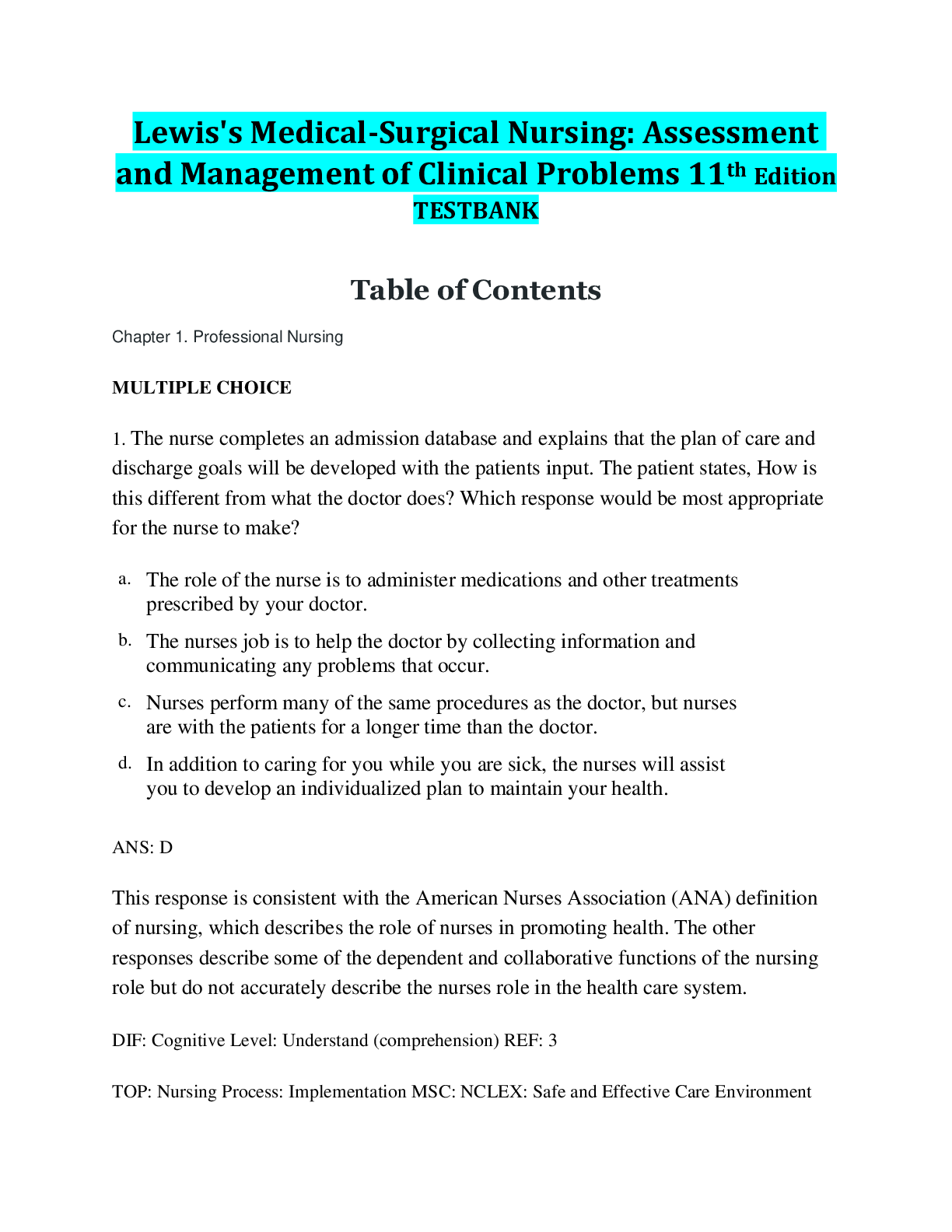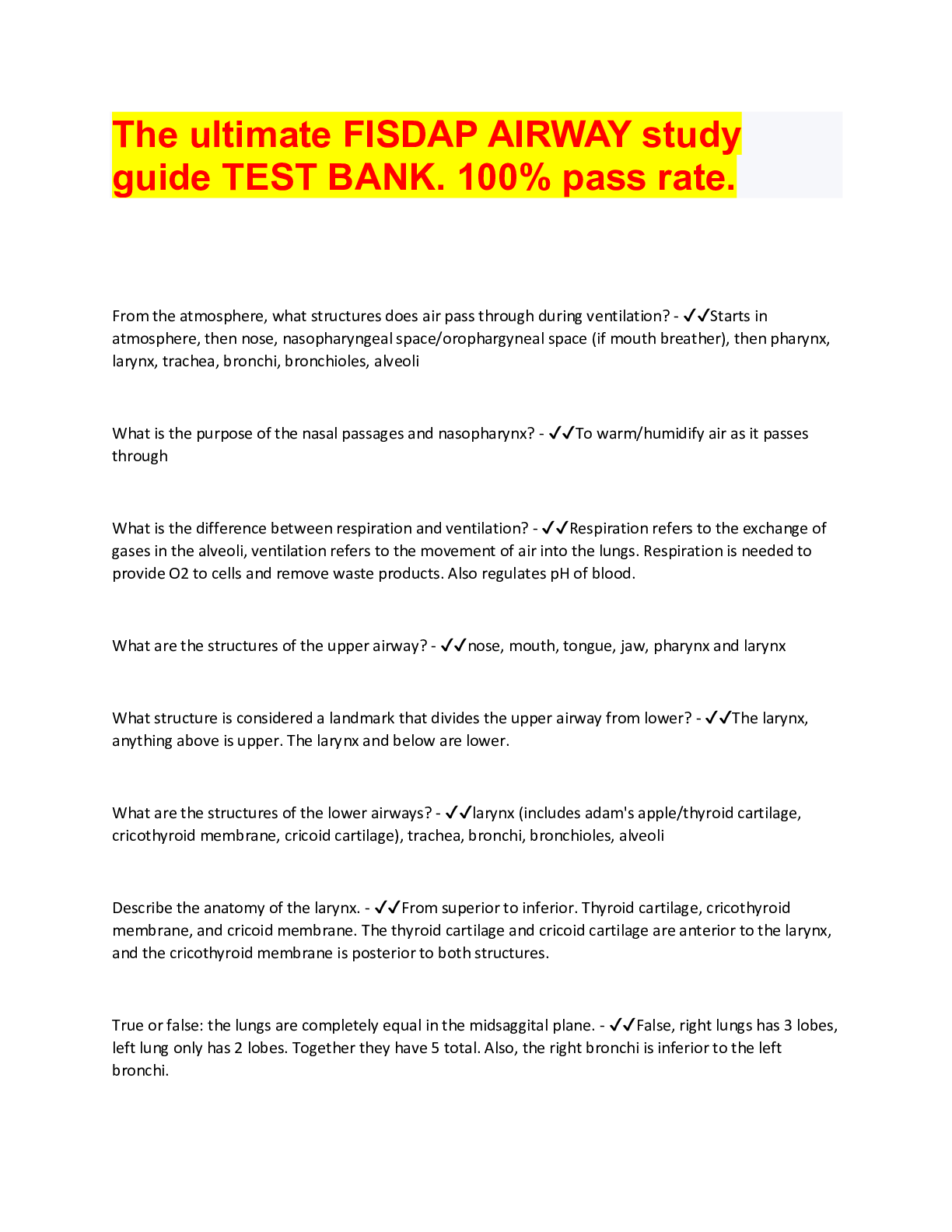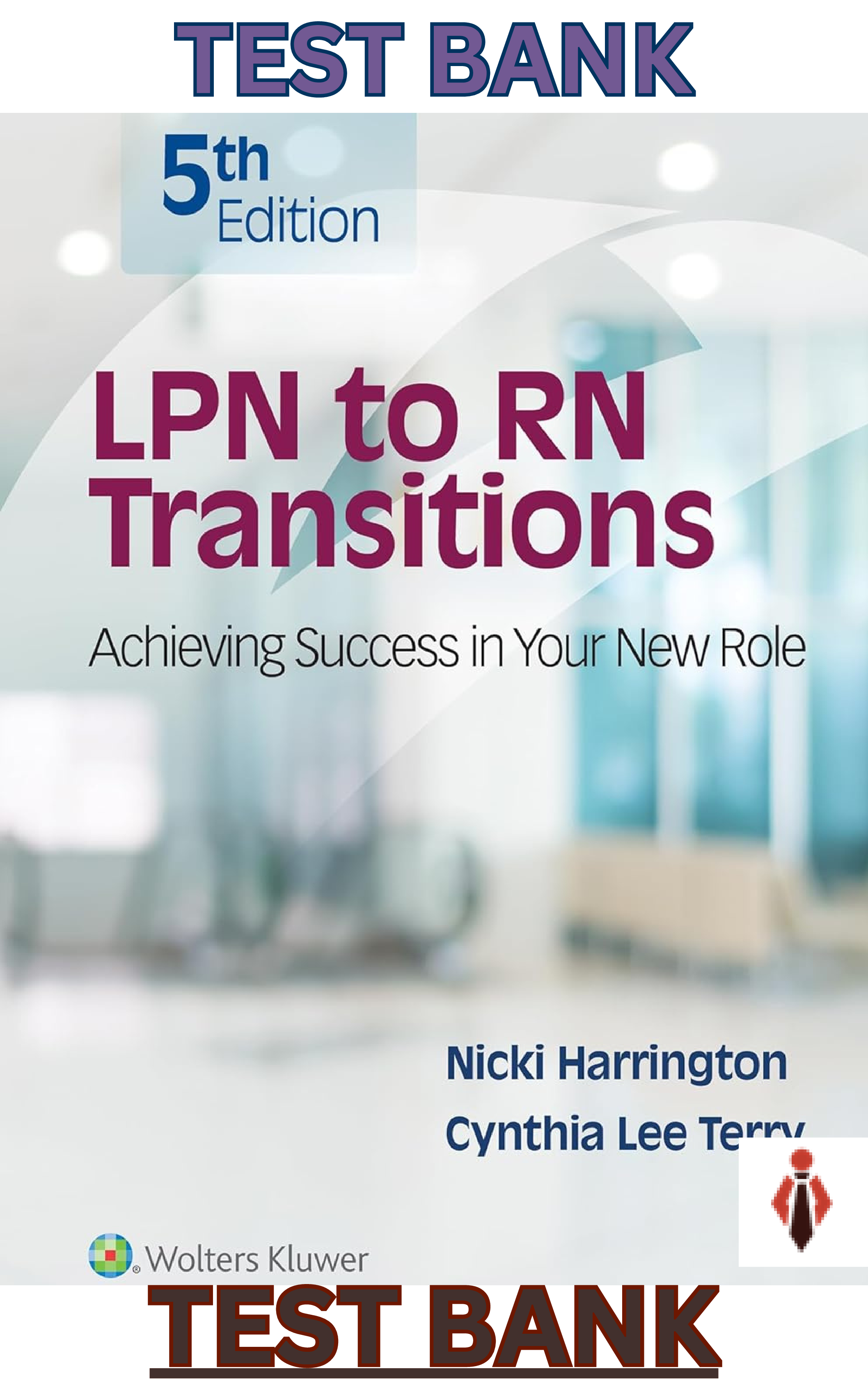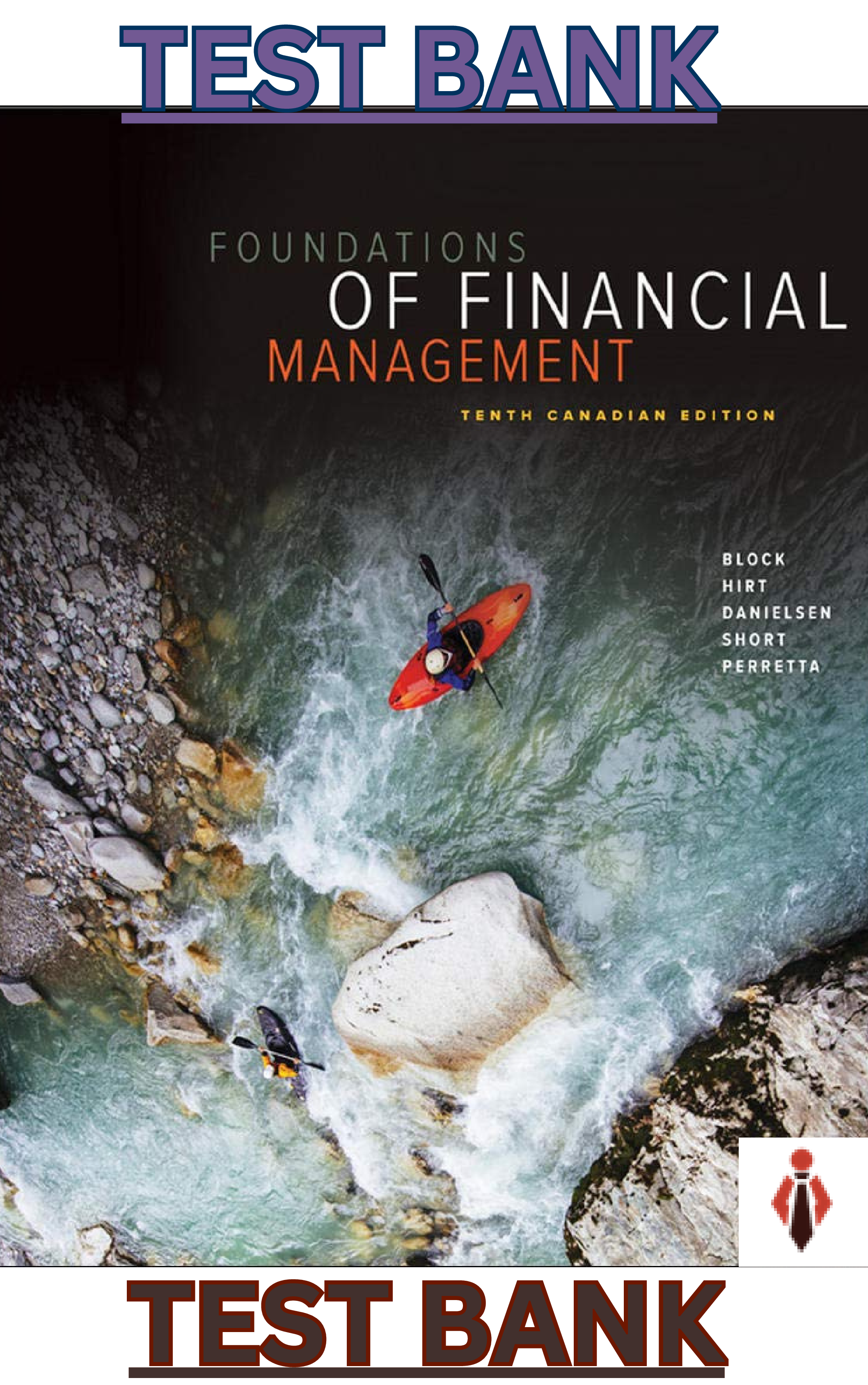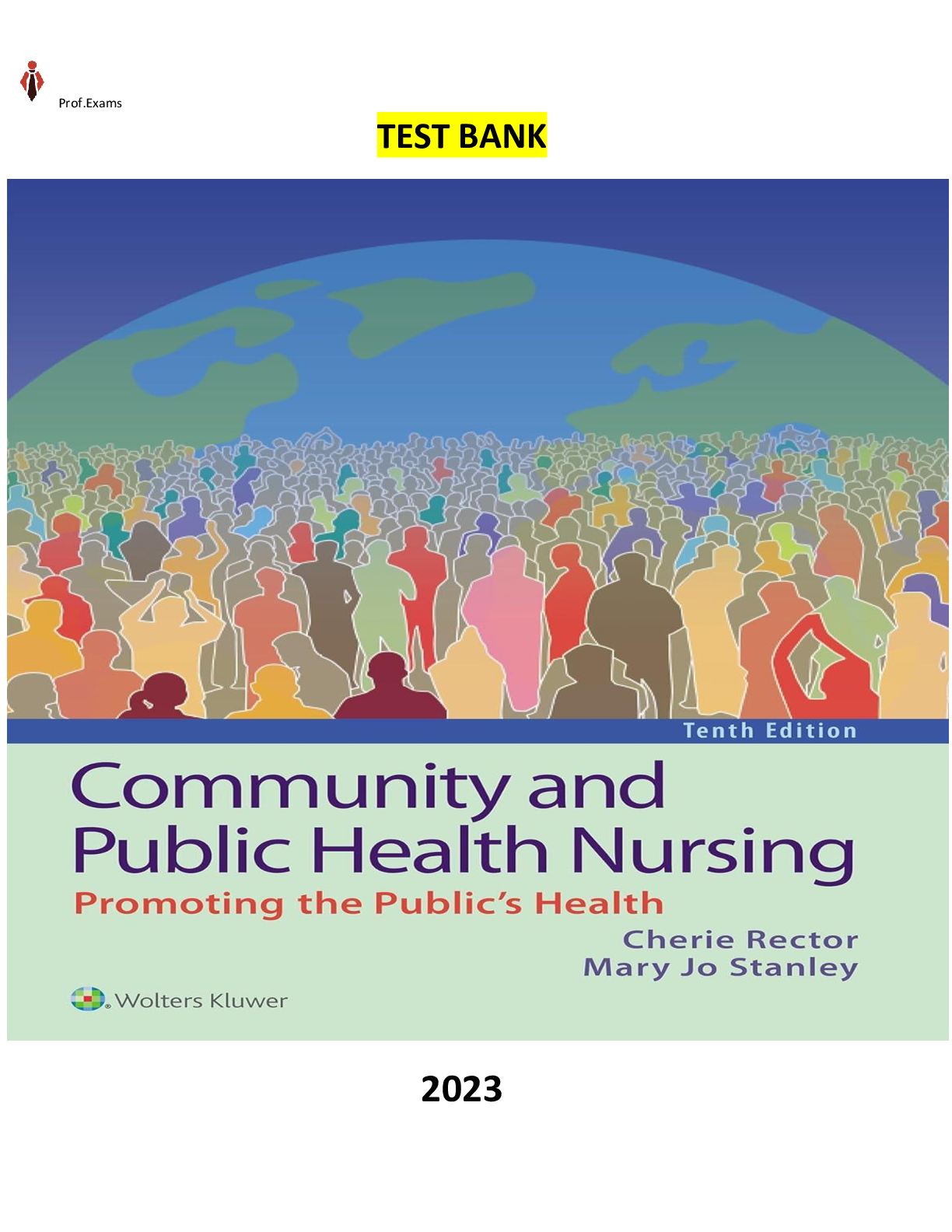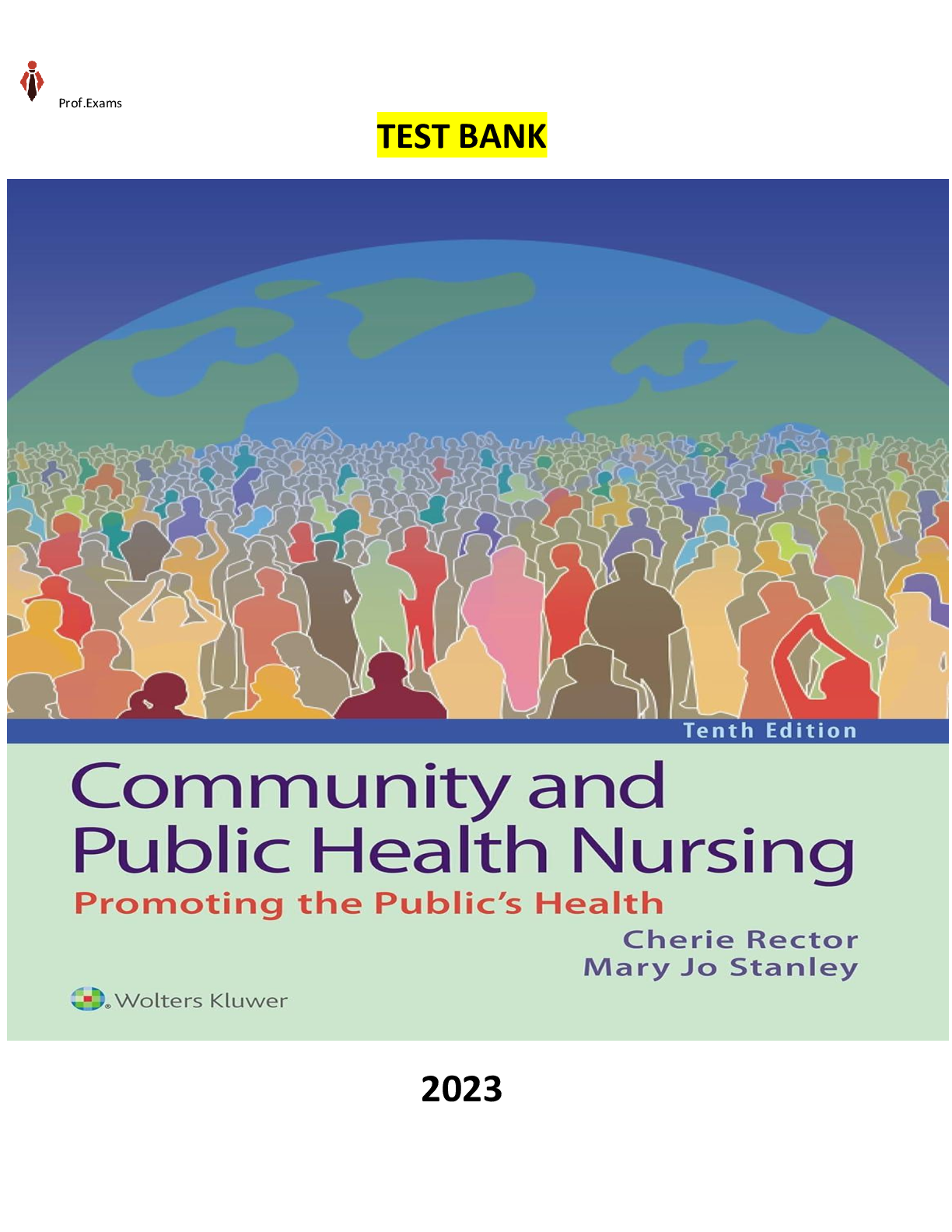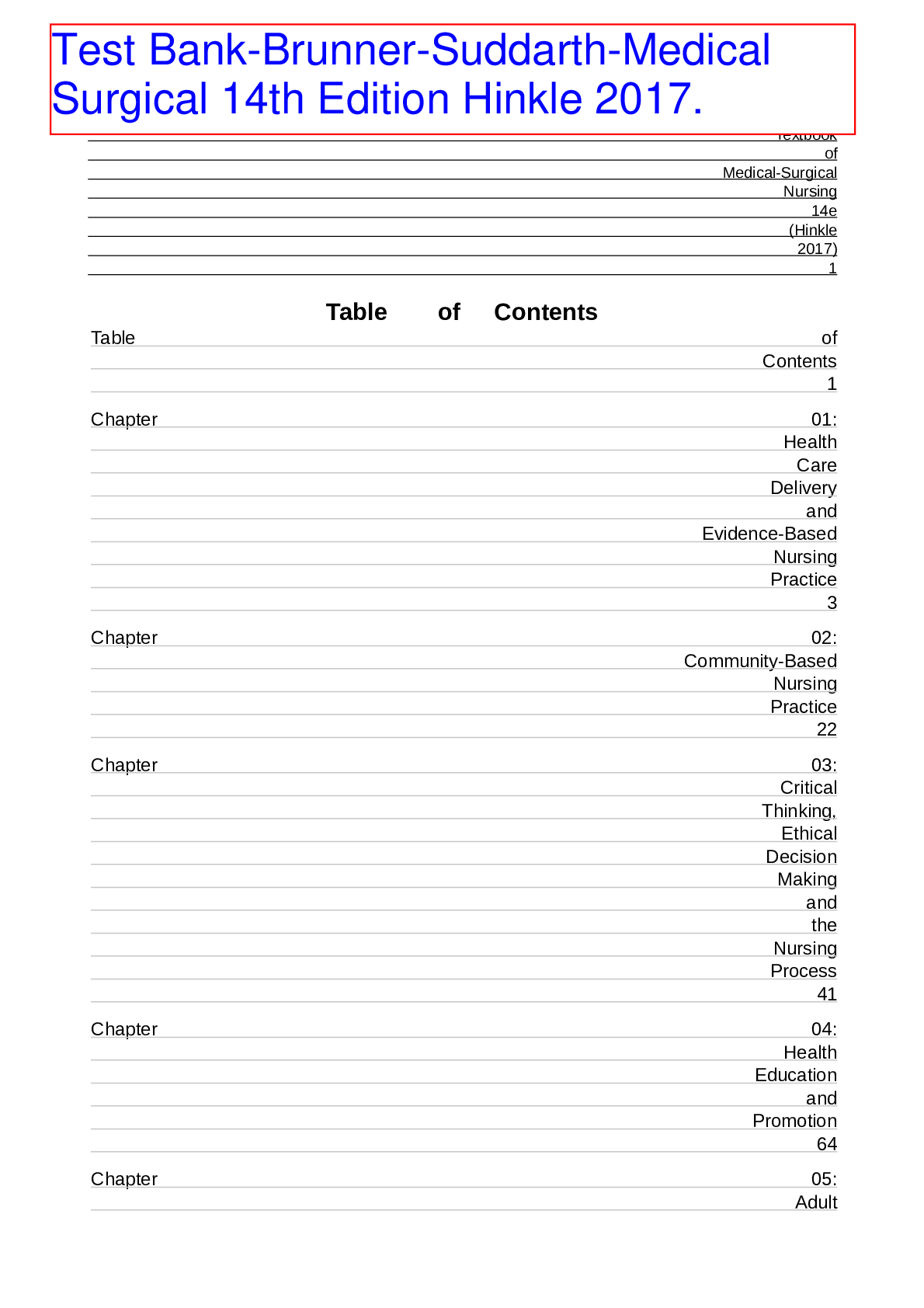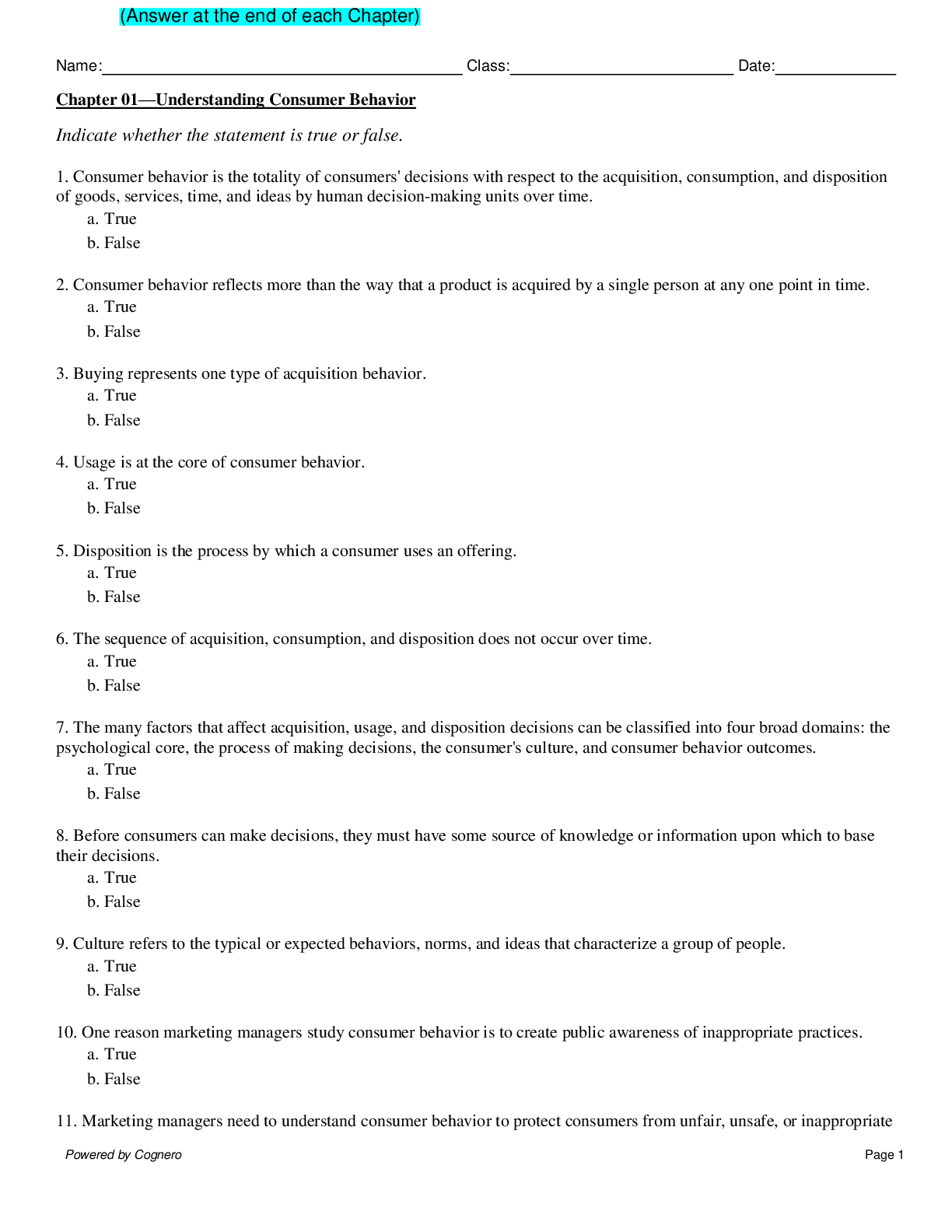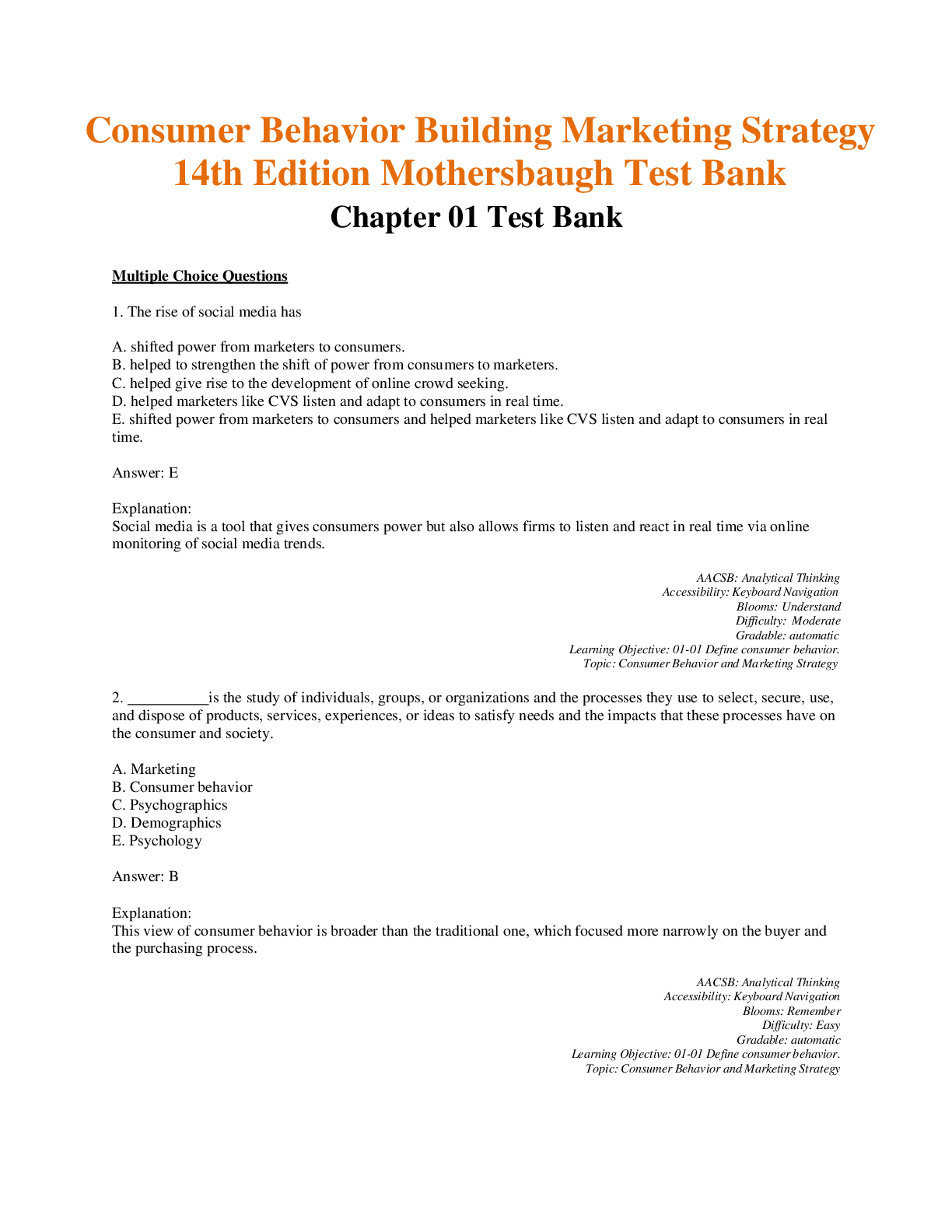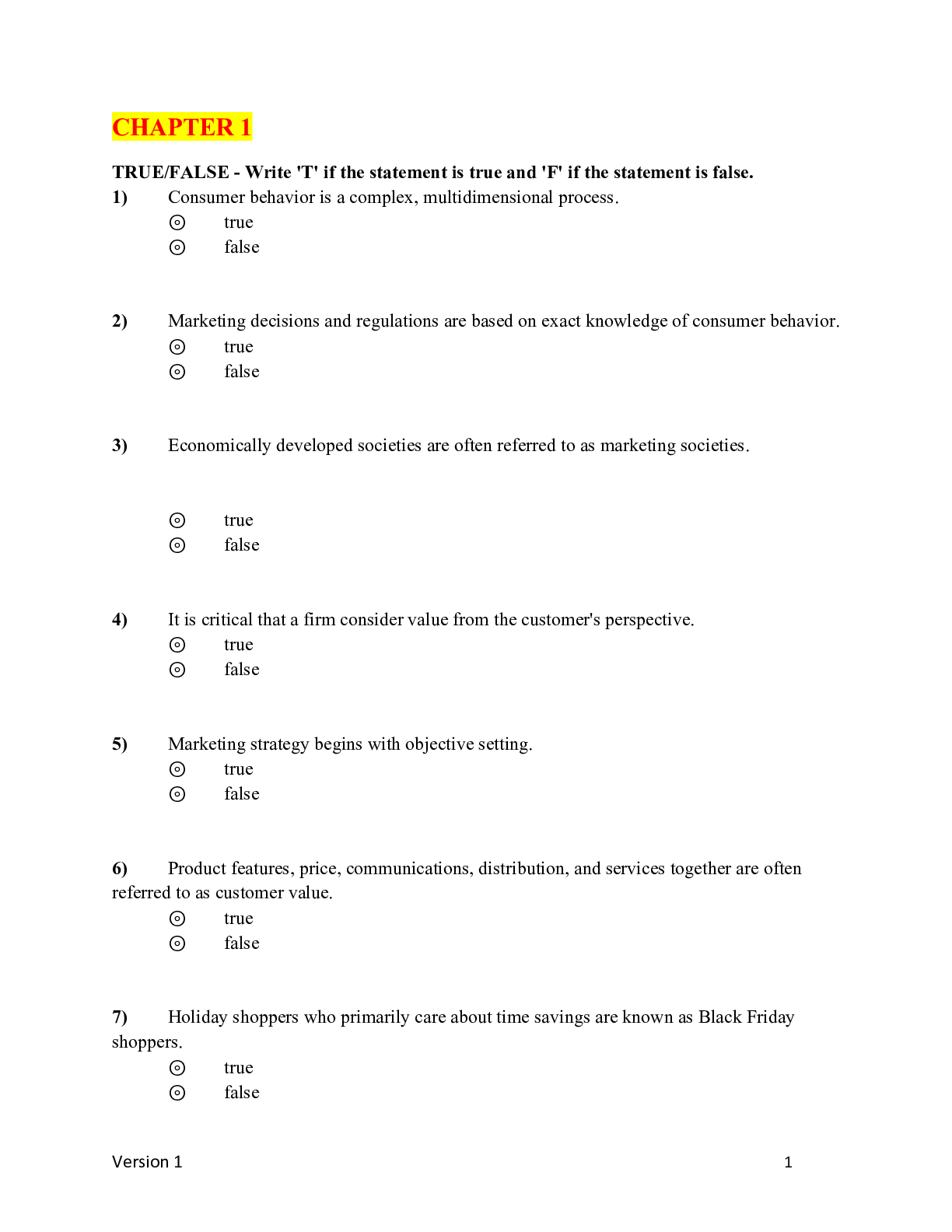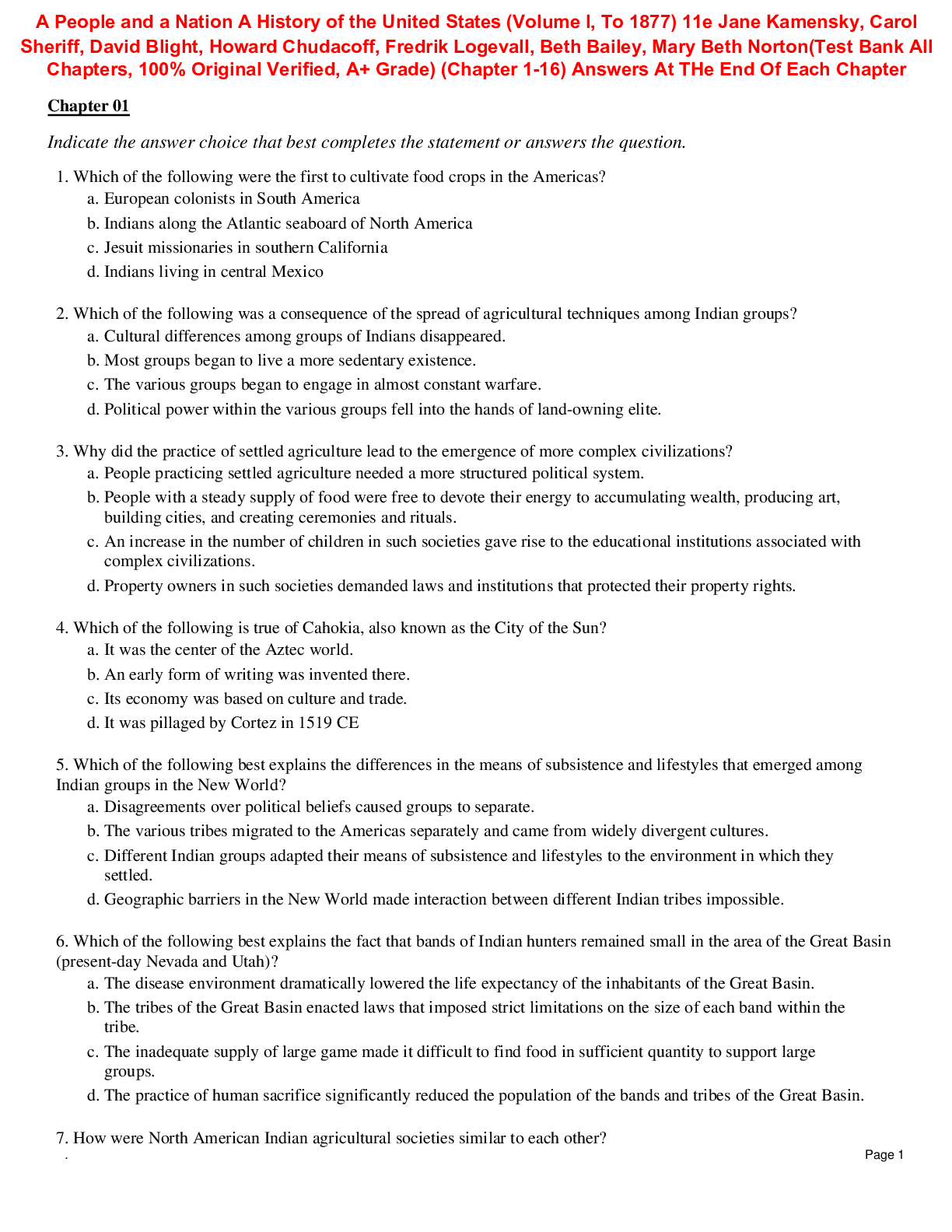Health Care > TEST BANK > ALL TNCC QUESTIONS BANK...., Tncc, TNCC Written Exam, TNCC Written Exam, TNCC class, TNCC/TCRN, TNCC (All)
ALL TNCC QUESTIONS BANK...., Tncc, TNCC Written Exam, TNCC Written Exam, TNCC class, TNCC/TCRN, TNCC Written Exam Review, TNCC, TNCC Skill Demonstration, Tncc, TNCC, TNCC EXAM, TNCC Written Exam, TNCC Written Exam, Tncc, TNCC, Trauma Nursing II, TNCC feb 2018
Document Content and Description Below
Primary concern when a person cannot stop coughing/clearing their throat following house fire/smoke? -✔✔☑ Airway/Intubate Lab evidence of cellular perfusion -✔✔☑ Base Excess (Less than -... 6 is BAD) Multiple people are in the ER of different ages who all go to the same church. They all have the same symptoms. What is the most likely cause? -✔✔☑ Biologic Suspected shock type with a spinal cord injury -✔✔☑ Distributive Shock (Includes neurogenic) Patient has GCS of 3, unequal pupils (one sluggish, one blown), and is posturing. What is the cause? - ✔✔☑ Herniation Middle Meningeal Artery -✔✔☑ Epidural Hematoma (results from collection of blood that forms between dura mater and skull) Prior to having a concussion (TBI), the patient had a brain injury that was not fully healed. What is the cause? -✔✔☑ 2nd Impact Syndrome Bowel sounds heard in the L chest. What is this a symptom of? -✔✔☑ Ruptured diaphragmSymptoms of __________________: include muffled heart sounds and hypotension -✔✔☑ Pericardiocentesis How should you dress a severed limb? -✔✔☑ Sterile gauze with normal saline THEN put ice on it Amylase level looks at _____________ -✔✔☑ Pancreas What should you do if your patient has hyphema (collection of blood inside the front part of the eye?) - ✔✔☑ Sit HOB up to 30 degrees Principle that people have to take action after suffering a loss in order to decrease severity, seriousness, or painfulness -✔✔☑ Mitigation What organ is most at risk following a gunshot -✔✔☑ Liver 8 year old child with longitudinal thigh lacerations -✔✔☑ Sign of child abuse Bleeding around belly button -✔✔☑ Cullen's Sign What would cause an inaccurate reading from an 02 saturation probe? -✔✔☑ Carboxyhemoglobin (increase FiO2 to 100%) General study of forces and their effects on living tissue and the human body -✔✔☑ Biomechanics Study of energy transfer as it applies to identifying actual or potential injuries -✔✔☑ Kinematics Refers to the separation of tissue resulting from a sound and/or hydraulic wave force- the effect is a crushing pressure wave which creates a temporary cavity, followed by a rapid and violent closing of the cavity. -✔✔☑ CavitationThis rapid motion can lead to crushing, tearing, and shearing forces on tissue -✔✔☑ Cavitation Used in OR; does not provide protection against aspiration and not recommended in patients who have eaten recently. It is a supraglottic airway. -✔✔☑ Laryngeal Mask Airway Single tube retroglottic device inserted into the esophagus and traps the glottis opening between an esophageal cuff and an oropharyngeal cuff. Designed with 2 ports/lumens each with a separate cuff. Does NOT provide protection against aspiration and is not indicated in children. It is a retroglottic airway. -✔✔☑ King Tube Types of Shock (4) -✔✔☑ Hypovolemic, Obstructive, Cardiogenic, Distributive Hemorrhage is the leading cause. Can result from vomiting, diarrhea, and burn trauma. Decreased circulating volume --> decreased preload. Therapy includes replacing the type of volume that was lost. - ✔✔☑ Hypovolemic Shock Results from hypo perfusion of tissue due to an obstruction in either the vasculature or heart. Therapy aimed at relieving the obstruction and improving perfusion. -✔✔☑ Obstructive Shock Two classic examples of obstructive shock -✔✔☑ Cardiac tamponade and tension pneumothorax Results from pump failure in the presence of adequate intravascular volume. Lack of CO and end-organ perfusion secondary to a decrease in myocardial contractility and/or valvular insufficiency. Therapy includes inotropic support, antidysrhythmic medications, and correction or treatment of underlying cause. -✔✔☑ Cardiogenic Shock Results from the misdistribution of an adequate circulating blood volume with the loss of vascular tone or increased permeability. Treatment is to provide volume replacement, increase systemic vascular resistance with medications (pressors) and possible antibiotics. -✔✔☑ Distributive Shock Examples that can cause distributive shock -✔✔☑ Anaphylactic shock, septic shock, neurogenic shock___________________: Impairs thrombin production and platelet function _____________ ______________: Impairs thrombin production _______________________: Results in depletion of clotting factors through hemodilution and the impaired ability to produce clotting factors. -✔✔☑ Trauma Triad of Death 1. Hypothermia 2. Metabolic Acidosis 3. Coagulopathy Stages of Shock (3) -✔✔☑ 1. Compensated 2. Decompensated vs Progressive 3. Irreversible Complete craniofacial separation involving maxilla, zygoma, orbits, and bones of the cranial base. Assessment findings include: massive facial edema, mobility and depression of zygomatic bones, ecchymoses, diplopia, and open bite or malocclusion. -✔✔☑ LeFort III Transverse maxillary bone fracture that occurs above the level of the teeth from the maxilla. Assessment findings include: independent moment of the maxilla from the rest of the face, slight swelling of the maxillary area, lip laceration or fractured teeth, malocclusion. -✔✔☑ LeFort I Pyramidal maxillary bone fracture involving the mid-face area. The apex of the fracture transverses the bridge of the nose. Assessment findings include: massive facial edema, nasal swelling with obvious fracture of the nasal bones, malocclusion, CSF rhinorrhea -✔✔☑ LeFort II Can be caused by blunt trauma. Air escapes from the injured lung into the pleural space, and negative intrapleural pressure is lost resulting in partial or complete collapse of the lung. S & S: dyspnea, tachypnea, decreased/absent breath sounds on injured side, chest pain. Treatment: based on size, symptoms, and stability. Chest tube may be placed to evacuate pleural air and maintain lung expansion - ✔✔☑ Pneumothorax Air enters the intrapleural space but cannot escape on expiration. The increasing intrathoracic pressure causes the lung on the injured side to collapse. If pressure is not relieved, the mediastinum can shifttoward the uninjured side compressing the heart/great vessels/and opposite lung. S & S: anxiety, severe restlessness, severe respiratory distress, significantly diminished or absent breath sounds on injured side, hypotension, distended neck/head/upper extremity veins, tracheal deviation, or a shift toward uninjured side. Treatment: Needle thoracentesis and chest tube insertion -✔✔☑ Tension Pneumothorax Collection of blood in pericardial sac. Mechanism of injury is typically penetrating trauma. Compresses the heart and decreases ability of the ventricles to fill causing decreased SV and CO. S & S: hypotension, muffled heart sounds, distended neck veins, tachycardia or PEA, dyspnea, cyanosis, chest pain. Surgical evacuation will be needed. -✔✔☑ Cardiac Tamponade __________________ Shock: Spinal cord injury at T6 or above. Temporary loss of vasomotor tone and sympathetic innervation. Temporary duration usually <72 hours. S & S: hypotension, bradycardia, loss of ability to sweat below level of injury. -✔✔☑ Neurogenic ______________ Shock: Spinal cord injury at any level. Transient loss of reflex below the level of injury. Variable duration. S & S: flaccidity, loss of reflexes, bowel/bladder dysfunction. -✔✔☑ Spinal Significant muscle damage and cellular destruction releases myoglobin: a muscle protein; into the bloodstream. Classic symptoms: muscle pain/numbness/changes in sensation, muscle weakness/paralysis, dark red/brown urine. -✔✔☑ Rhabdomyolysis What does MIST mnemonic mean? -✔✔☑ M: Mechanism of Injury I: Injuries sustained S: S&S in the field T: Treatment in the field Older adults are harder to intubate due to ______________ ____________ -✔✔☑ cervical arthritis Leading cause of preventable death after injury -✔✔☑ Hemorrhage Room Air = ____% FiO2 -✔✔☑ 21%1 Liter of O2 = ____% FiO2 -✔✔☑ 4% Patient snoring = insert __________ airway -✔✔☑ Oral Airway (OPA) Avoid _______________ when administering oxygen/ventilation -✔✔☑ hyperoxia Resuscitation Adjuncts (LMNOP) -✔✔☑ L: Lab M: Monitor cardia rhythm and rate N: Naso or Oro-gastric tube insertion O: Oxygenation or ventilation analysis P: Pain assessment and management Do not place ___________________ in head trauma patients -✔✔☑ nasogastric Right breath sound ONLY following intubation = ________________ -- pull out -✔✔☑ Mainstem Massive Blood Transfusion: Monitor ___________ levels: sodium acetate binds with ____ so levels decrease. -✔✔☑ Calcium Hypercapnia causes _________________; Hypocapnia causes __________________ -✔✔☑ Vasodilation; Vasoconstriction Usually seen in athletes, second TBI, 2nd injury occurs BEFORE 1st injury recovers, rare but usually fatal. -✔✔☑ Second Impact Syndrome ____________ ___________ Injury: shearing or tearing. Diagnosed with MRI. Widespread microscopic hemorrhage. -✔✔☑ Diffuse Axonal Injury (Cannot recover from this; shearing/tearing portion DOES NOT heal) Muffled heart sounds -✔✔☑ Cardiac tamponade? Pericardial fluid?Most frequently injured organ -✔✔☑ Liver Most frequently injured organ from BLUNT trauma -✔✔☑ Spleen Pain Ladder: Step 1: Non-opioids for mild pain Step 2: Weak opioids for mild to moderate pain Step 3: Strong opioids for moderate to severe pain -✔✔☑ 1: Tylenol, Ibuprofen, Ketorolac 2: Codeine 3: Morphine, Fentanyl, Dilaudid Signs of increased compartment syndrome -✔✔☑ Increased pain, feels tight/very painful, but nothing looks wrong Ischemia develops -- Pressure Fasical Development -- Impaired Blood Flow. 6 P's: Pressure, pallor, pulses, paresthesia, paralysis. Extremity goes to level of the ___________!!! NO ______!! -✔✔☑ Compartment Syndrome: Level of heart; NO ice!! Control bleeding with direct pressure, elevate, apply tourniquets. -✔✔☑ Amputation Wrap in saline gauze, put in bag, then put that bag in another bag filled with ice. Label bag. -✔✔☑ Removed limb A ____ and ___ approach is used by all members of the trauma team to provide optimal care for the trauma pt. -✔✔☑ Systematic , Organized Trauma is injury to living tissue caused by ... -✔✔☑ An extrinsic agentA traumatic incident may be classified as ....(assault or suicide) or ... (falls or collisions) -✔✔☑ Intentional;unintentional .... is the study of energy transfer as it applies to identifying actual or potential injuries -✔✔☑ Kinematics The general study of forces and their effects -✔✔☑ Biomechanics How external forces in the environment are transferred to the body -✔✔☑ Mechanism of injury A body at rest will remain at rest, a body in motion will stay in motion -✔✔☑ Newton's first law Force = mass x acceleration -✔✔☑ Newton's second law For every action there is an equal and opposite reaction -✔✔☑ Newton's third law Energy can neither be created nor destroyed but rather I can change form -✔✔☑ Law of conservation of energy Kinect is energy is equal to ... -✔✔☑ 1/2 the mass x by the velocity squared (v^2) Caused by a sudden stop of the body's motion -✔✔☑ Deceleration forces Caused from a sudden and rapid onset of motion ( a Parker car being hit by another vehicle) -✔✔☑ Acceleration forces An external force applied time of impact, ex. Steering wheels or dashboards that collide with or push up into a person. -✔✔☑ Compression force .... is the major cause of preventable death after injury -✔✔☑ Uncontrolled hemorrhage.... is suspected in any patient with multi system trauma. -✔✔☑ Cervical spine injury ... shock is from hemorrhage and is the leading cause of preventable deaths in trauma patients. Can also be caused by plasma loss in ... -✔✔☑ Hypovolemic; burns ... shock results from hypoperfusion of the tissue due to an obstruction in either the vasculature or heart. Two examples include.... -✔✔☑ Obstructive;tension pneumothorax, cardiac tamponade. (With tension pneumo the increase in intrathoracic pressure leads to displacement of the vena cava, obstruction to arrival filling leading to decreased preload and decreased cardiac output) ( with cardiac tamponade there is an accumulation of fluid in the pericardial sac impeding diastolic expansion and filling leading to decreased preload, stroke volume,CO and end organ perfusion) ... shock occurs as a result of maldistribution of an adequate circulation blood volume with the loss of vascular tone or increased permeability. 3 examples. -✔✔☑ Distributive; anaphylactic, septic and neurogenic .... activation: .... are found in the carotid sinus and along the aortic arch, are sensitive to the degree of stretch in the arterial wall. When the receptors sense a decrease in stretch, they stimulate the sympathetic nervous system to release Epi, norepi, causing stimulation of cardiac activity and constriction of blood vessels, which causes a rise in heart rate and diastolic blood pressure -✔✔☑ Baroreceptor activation; baroreceptors ...activation: consist of carotid and aortic bodies. ... detect changes in blood oxygen and Co2 and pH. When Co2 rises or oxygen level of pH falls these receptors are activated and information is relayed to the CNS and the cardiorespiratory centers in the medulla , which increases respiratory rage and depth and BP -✔✔☑ Chemoreceptors In the ... ... response two catecholamines are released ... and ... . -✔✔☑ Adrenal gland response; epinephrine and norepinephrine In the adrenal gland response ... is released to raise blood glucose and promote renal retention of water and sodium. -✔✔☑ Cortisol... is the initial post traumatic inflammatory response. ... ... activates this response and ... are sent to the injury sites, activating signaling pathways that mobilize inflammatory cells. -✔✔☑ Immune response; tissue hypoxia;neutrophils What stage of shock: anxiety, restless, confused, norm systolic pressure, rising diastolic pressure, slightly tachycardiac, increased RR and decreased urine output -✔✔☑ Stage I: compensated What stage of shock:patient is unconscious or intended, normal systolic pressure, narrowing pulse pressure, tachycardia, weak and threads pulses, rapid and shallow respiration, cool and clammy, worsening base excess and increasing Lacoste levels -✔✔☑ Stage II: decompensated or progressive shock What stage of shock?: this will lead to death without rapid intervention, obtunded, stuporous or comatose, marked hypotension and heart failure, bradycardia, decreased and shallow respirations, pale, cool and clammy, organ failure and severe acidosis -✔✔☑ Stage III: irreversible shock ... is a principle that confuses on prevention rather than intervention. -✔✔☑ Damage control resuscitation The components of the neurological system involved with pain transmission include... -✔✔☑ Neurons, neuron synapses and neurotransmitters ... pain is persistent and usually lasts longer than 3 to 6 months. -✔✔☑ Chronic ... describes the concept of under treatment of pain. -✔✔☑ Oligoanalgesia The most reliable and valid tool for pain assessment is ... -✔✔☑ Self-report Causes of oligoanalgesia include... -✔✔☑ Failure to assess initial pain; failure to implement guidelines and protocols; failure to document pain; failure to meet patients expectationsThe meninges consist of three layers of protective coverings ... -✔✔☑ (PAD) pia matter, arachnoid matter and dura matter Adequate perfusion of oxygen and supply of nutrients to the brain tissue is dependent on ... and ... - ✔✔☑ CPP; CBF ... is defined as the pressure gradient across the brain tissue, or the difference between the pressures of the cerebral artery and venous vessels. -✔✔☑ CPP; CPP = map - icp Normal CPP is ... Acceptable CPP is ... During this auto regulation maintains in a steady state. -✔✔☑ 60 to 100; 50 to 70 ... is a triad of assessment findings; widening pulse pressure, bradycardia, and diminished respiratory effort -✔✔☑ Cushing ( it is an attempt to increase MAP against elevated ICP, ultimately trying to cause a rise in CPP) ... pain originates from skin and musculoskeletal structures (burns) -✔✔☑ Somatic ... pain originates from organs and may lead to referred pain. (Trauma) -✔✔☑ Visceral If injury causes the CPP to fall outside the range of 50 - 160, the brain loses its ability to ... and CBF is directly dependent on ... for perfusion -✔✔☑ Auto regulate ; MAP Normal Co2 ... -✔✔☑ 35-45 Co2 ... causes dilation of cerebral arterial vasculature and increased blood flood and increased ICP. ... causes constriction and decreased blood flow.! -✔✔☑ Hypercapnia; hypocapnia Signs of impending herniation include ... -✔✔☑ Unilateral or bulge risk pupillary dilation, asymmetric pupillary reactivity or abnormal posturingAs ICP increases CPP decreases resulting in ... -✔✔☑ Cerebral ischemia, hypoxemia and lethal secondary insult Early findings of increased ICP include -✔✔☑ Headache, nausea and vomiting, amnesia, behavior changes, altered level consciousness Late findings of increased ICP include -✔✔☑ Dilated, nonreactive pupils, unresponsiveness, abnormal posturing, Cushing response, bradycardia, decreased respiratory Effort .... can produce bleeding that may not be evident until several hours after injury -✔✔☑ Basilar skull fractures The three areas of basilar skull fractures include ... -✔✔☑ Periodontal D.C. my Isra (raccoon eyes - fossa fracture) Mastoid process ecchymoses (behind the ear) Hemotympanum (blood in the tympanic membrane/middle ear) ... is a test that requires fluid to be sent to the lab and is considered the gold standard for identifying CSF -✔✔☑ Beta2-Transferrin What are two quick tests for general suspicion of CSF leak? -✔✔☑ Halo sign and glucose ... is damaged brain tissue usually caused by blunt trauma -✔✔☑ Cerebral contusion Where are most cerebral contusions found -✔✔☑ Frontal and temporal lobes Signs and symptoms of intracerebral hematoma include ... -✔✔☑ Progressive and rapid decline, headache, signs of increasing ICP, pupil abnormalities... results from a collection of blood forming between the dura Mater and the skull. This is frequently associated with fractures of the temporal or parietal skull that lacerated the .... -✔✔☑ Epidural hematoma ; middle meninges artery This is commonly the type of bleed sustained by athletes who suffer a catastrophic head injury. -✔✔☑ Acute subdue all hematoma .... are frequently associated with minor injury in older adults, patients taking anticoagulation medications and patients with chronic alcohol abuse. -✔✔☑ Chronic subdural Hematoma ... is the shifting of brain tissue with displacement into another compartment as the result of bleeding or edema. -✔✔☑ Herniation GCS scores : I. Mild TBI II. Moderate TBI III. Severe TBI -✔✔☑ 13-15; 9-12; 8 or less ... refers to a condition that occurs when the patient suffers a second milks TBI before recovery from the first -✔✔☑ Second impact syndrome Patients who sustain a mild TBI may develop .... . Typically it will manifest several days or moths after head trauma. -✔✔☑ Postconcussive syndrome A ... fracture is a complete craniofacial separation -✔✔☑ Lefort III Assessment findings with maxillary fractures include -✔✔☑ Facial edema, ecchymoses and diplopoa (lefort III)What are some interventions for the patient with a brain, cranial or macillofacial trauma -✔✔☑ Elevation of patients head of bed by 30 degrees to decrease ICP, position head midline, ICP monitoring device Treatment of corneal abrasion includes -✔✔☑ Topical antibiotics, oral analgesics NO patching , topical anti inflammatory What are the late signs of breathing compromise? -✔✔☑ - Tracheal deviation - JVD What are signs of ineffective breathing? -✔✔☑ - AMS - Cyanosis, especially around the mouth - Asymmetric expansion of chest wall - Paradoxical movement of the chest wall during inspiration and expiration - Use of accessory muscles or abdominal muscles or both or diaphragmatic breathing - Sucking chest wounds - Absent or diminished breath sounds - Administer O2 via NRB or assist ventilations with a bag-mask device, as indicated - Anticipate definitive airway management to support ventilation. Upon initial assessment, what type of oxygen should be used for a pt breathing effectively? -✔✔☑ A tight-fitting nonrebreather mask at 12-15 lpm. What intervention should be done if a pt presents with effective circulation? -✔✔☑ - Insert 2 large caliber IV's - Administer warmed isotonic crystalloid solution at an appropriate rate What are signs of ineffective circulation? -✔✔☑ - Tachycardia - AMS - Uncontrolled external bleeding- Pale, cool, moist skin - Distended or abnormally flattened external jugular veins - Distant heart sounds What are the interventions for Effective/Ineffective Circulation? -✔✔☑ - Control any uncontrolled external bleeding by: - Applying direct pressure over bleeding site - Elevating bleeding extremity - Applying pressure over arterial pressure points - Using tourniquet (last resort). - Cannulate 2 large-caliber IV's and initiate infusions of an isotonic crystalloid solution - Use warmed solution - Use pressure bags to increase speed of IVF infusion - Use blood administration tubing for possible administration of blood - Use rapid infusion device based on protocol - Use NS 0.9% in same tubing as blood product - IV = surgical cut-down, central line, or both. - Blood sample to determine ABO and Rh group - IO in sternum, legs, arms or pelvis - Administer blood products - PASG (without interfering with fluid resuscitation) What are factors that contribute to ineffective ventilation? -✔✔☑ - AMS - LOC - Neurologic injury - Spinal Cord Injury - Intracranial Injury - Blunt trauma - Pain caused by rib fractures- Penetrating Trauma - Preexisting hx of respiratory diseases - Increased age What medications are used during intubation? -✔✔☑ LOAD Mnemonic: L = Lidocaine O = Opioids A = Atropine D = Defasiculating agents What are the Rapid Sequence Intubation Steps? -✔✔☑ PREPARATION: - gather equipment, staffing, etc. PREOXYGENATION: - Use 100% O2 (prevent risk of aspiration). PRETREATMENT: - Decrease S/E's of intubation PARALYSIS WITH INDUCTION: - Pt has LOC, then administer neuromuscular blocking agent PROTECTION AND POSITIONING: - Apply pressure over cricoid cartilage (minimizes likelihood of vomiting and aspiration PLACEMENT WITH PROOF - Each attempt NOT to exceed 30 seconds, max of 3 attempts. Ventilate pt 30-60 seconds between attempts. - After intubation, inflate the cuff - Confirm tube placement w/exhaled CO2 detector. POSTINTUBATION MANAGEMENT: - Secure ET tube - Set ventilator settings - Obtain Chest x-ray- Continue to medicate - Recheck VS and pulse oxtimetry What is a Combitube? -✔✔☑ A dual-lumen, dual-cuff airway that can be placed blindly into the esophagus to establish an airway. If inadvertently placed into trachea, it can be used as a temporary ET tube. There are only two sizes: small adult and larger adult. What is a Laryngeal Mask Airway? -✔✔☑ Looks like an ET tube but is equipped with an inflatable, elliptical, silicone rubber collar at the distal end. It is designed to cover the supraglottic area. ILMA, does not require laryngoscopy and visualization of the chords. What is Needle Cricothyrotomy -✔✔☑ Percutaneous transtracheal ventilation. (temporary) Complications include: - inadequate ventilation causing hypoxia - hematoma formation - esophageal perforation - aspiration - thyroid perforation - subcutaneous emphysema What is Surgical Cricothyrotomy? -✔✔☑ Making an incision in cricothyroid membrane and placing a cuffed endo or trach tube into trachea. This is indicated when other methods of airway management have failed and pt cannot be adequately ventilated and oxygenated. Complications include: - Aspiration - Hemorrhage or hematoma formation or both - Lac to trachea or esophagus- Creation of a false passage - Laryngeal stenosis How do you confirm ET Tube/Alternative Airway Placement? -✔✔☑ - Visualization of the chords - Using bronchoscope to confirm placement - Listening to breath sounds over the epigastrum and chest walls while ventilating the pt - CO2 detector - Esophageal detection device - Chest x-ray How do you inspect the chest for adequate ventilation? -✔✔☑ Observe: - mental status - RR and pattern - chest wall symmetry - any injuries - patient's skin color (cyanosis?) - JVD or tracheal deviation? (Tension pneumothorax) What are you looking for when auscultating lung sounds? -✔✔☑ Absence of BS: - Pneumothorax - Hemothorax - Airway Obstruction Diminished BS: - Splinting or shallow BS may be a result of pain What are you looking for when percussing the chest? -✔✔☑ Dullness: - hemothorax Hyperresonance- Pneumothorax What are you looking for when palpating the chest wall, clavicles and neck? -✔✔☑ - Tenderness - Swelling - subcutaneous emphysema - step-off deformities = These may indicate: esophageal, pleural, tracheal or bronchial injuries. Palpate trachea above suprasternal notch. Tracheal deviation may indicate a tension pneumothorax or massive hemothorax. What is the DOPE mnemonic? -✔✔☑ D - Displaced tube O - Obstruction: Check secretions or pt biting tube P - Pneumothorax: Condition may occur from original trauma or barotrauma from ventilator E - Equipment failure: pt may have become detached from equipment or there's a kink in the tubing Explain Hypovolemic Shock. -✔✔☑ Most common to affect a trauma pt cause by hypovolemia.. Hypovolemia, a decrease in amount of circulating blood volume, may result from significant loss of whole blood because of hemorrhage or from loss of semipermeable integrity of cellular membrane leading to leakage of plasma and protein from intravascular space to the interstitial space (as in a burn). Some causes: - Blood loss - Burns, etc. Explain Cardiogenic Shock. -✔✔☑ Syndrome that results from ineffective perfusion caused by inadequate contractility of cardiac muscle. Some causes: MI, Blunt cardiac injury, Mitral valve insufficiency, dysrhythmias, Cardiac Failure Explain Obstructive Shock. -✔✔☑ Results from inadequate circulating blood volume because of an obstruction or compression of great veins, aorta, pulmonary arteries, or heart itself.Some causes: - Cardiac tamponade (may compress the heart during diastole to such and extent that atria cannot adequately fill, leading to decreased stroke volume). - Tension pneumothorax may lead to inadequate stroke volume by displacing inferior vena cava and obstructing venous return to right atrium. - Air embolus may lead to obstruction of pulmonary artery and subsequent obstruction to right ventricular outflow during systole, with resulting obstructive shock Explain Distributive Shock. -✔✔☑ Results from disruption in SNS control of the tone of blood vessels, which leads to vasodilation and maldistribution of blood volume and flow. (Neurogenic and Septic Shock). Neurogenic shock may result from injury to spinal cord in cervical or upper thoracic region. Spinal shock = areflexia and flaccidity associated with lower motor neuron involvement in complete cord injuries; reflexes return with resolution of spinal shock. Septic shock from bacteremia is distributive shock. Endotoxins and other inflammatory mediators cause vasodilation, shunting of blood in microcirculation, and other perfusion abnormalities. What is vascular response? -✔✔☑ As blood volume decreases, peripheral blood vessels vasoconstrict as a result of sympathetic stimulation via inhibition of baroreceptors. Arterioles constrict to increase TPR and BP. What is renal response? -✔✔☑ Renal ischemia activates release of renin. Kidneys do not receive adequate blood supply, renin is release into circulation. Renin causes angiotensinogen, normal plasma protein, to release angiotensin I. Angiotensin-converting enzyme from the lungs converts into angiotensin II. Angiotensin II causes: - Vasoconstriction of arterioles and some veins- Stimulation of sympathetic nervous system - Retention of water by kidneys - Stimulation of release of aldosterone from the adrenal cortex (sodium retention hormone) *Decreased urinary output = early sign renal hypoperfusion and an indicator that there's systemic hypoperfusion. Explain adrenal gland response. -✔✔☑ When adrenal glands are stimulated by SNS, release of catecholamines (epinephrine and norepinephrine) from adrenal medulla will increase. Epi stimulates receptors in heart to increase force of cardiac contraction (positive inotropy) and increase HR (positive chronotropy) to improve cardiac output, BP and tissue perfusion. Shock stimulates hypothalamus to release corticotropin-releasing hormone that stimulates pituitary to release ACTH that stimulates adrenal gland to release cortisol. Effect of cortisol release is elevation in blood sugar and increased insulin resistance and gluconeogenesis, hepatic process to produce more sugar. Cortisol also causes renal retention of water and sodium, a compensatory mechanism to conserve body water. Explain Hepatic Response. -✔✔☑ Liver can store excess glucose as glycogen. As shock progresses, glycogenolysis is activated by epi to break down glycogen into glucose. In a compensatory response to shock, hepatic vessels constrict to redirect blood flow to other vital areas. Explain Pulmonary Response. -✔✔☑ Tachypnea happens for 2 reasons: 1. Maintain acid-base balance2. Maintain increased supply of oxygen * Metabolic acidosis from anaerobic metabolism will be a stimulus for the lungs to increase rate of ventilation. Increased RR is an attempt to correct acidosis + augments oxygen supply to maximize oxygen delivery to alveoli. Explain Irreversible Shock. -✔✔☑ Shock uncompensated or irreversible stages will cause compromises to most body systems. - Inadequate venous return - inadequate cardiac filling - decreased coronary artery perfusion - Membranes of lysosomes breakdown within cells and release digestive enzymes that cause intracellular damage. How would you assess a pt in hypovolemic shock? -✔✔☑ (Use Initial Assessment) and then: Inspect: - LOC - Rate and quality of respirations - External bleeding? - Skin color and moisture - Assess jugular veins and peripheral veins Auscultate: - BP - Pulse pressure - Breath sounds - Heart sounds - Bowel sounds Percuss: - Chest and abdomen Palpate:- Central pulse (carotid or femoral) - Positive inotropic effect (force of contraction) may be evidence by a bounding central pulse - Palpate peripheral pulses - Palpate skin temp and moisture Diagnostic Procedures: - Xrays and other studies - Labs Planning and Implementation - Oxygen - IV's with warmed replacement fluids - Control external bleeding with direct pressure - Elevate LE's - NGT - Foley - Monitor and pulse oximeter - Monitor for development of coagulopathies - Surgery? ICP is a reflection of what three volumes? What happens when one increases? -✔✔☑ 1. Brain 2. CSF 3. Blood within the nonexpansible cranial vault As volume of one increases, the volume of another decreases to maintain ICP within normal range. As ICP rises, CPP decreases, leading to cerebral ischemia and potential for hypoxia and lethal secondary insult. Hypotensive pt w/marginally elevated ICP can be harmful. Slightly elevated BP could protect against brain ischemia in a pt with high ICP. Cerebral ischemia can lead to increased concentration of CO2 and decreased concentration of O2 in cerebral vessels. CO2 dilates cerebral blood vessels = increase blood volume and ICP.What are the early signs and symptoms of increased ICP? -✔✔☑ - Headache - N/V - Amnesia regarding events around the injury - Altered LOC - Restlessness, drowsiness, changes in speech, or loss of judgement What are the late observable signs of symptoms of increased ICP? -✔✔☑ - Dilated, nonreactive pupil - Unresponsiveness to verbal or painful stimuli - Abnormal motor posturing patterns - Widening pulse pressure - Increased systolic blood pressure - Changes in RR and pattern - Bradycardia What is Cushing's phenomenon or Cushing's Reflex? -✔✔☑ Triad of progressive HTN, bradycardia and diminished respiratory effort. What are the two types of herniation that occurs with ICP? -✔✔☑ 1. Uncal herniation 2. Central or transtentorial herniation Why does herniation occur? What are the symptoms? -✔✔☑ Because of uncontrolled increases in ICP. S/E's - Unilateral or bilateral pupillary dilation - AsyDimmetric pupillary reactivity - Abnormal motor posturing - Other evidence of neurologic deteriorationDefine uncal herniation. -✔✔☑ The uncus (medial aspect of the temporal lobe) is displaced over the tentorium into the posterior fossa. This herniation is the more common of the two types of herniation syndromes. Define central or transtentorial herniation. -✔✔☑ A downward movement of the cerebral hemispheres with herniation of the diencephalon and midbrain through the elongated gap of the tentorium. Disruptions of the bony structures of the skull can result in what? -✔✔☑ Displaced or nondisplaced fx's causing CSF leakage b/c of lac to the dura mater, creating a passage for CSF. CSF leaks through the nose (rhinorrhea) or the ears (otorrhea). A potential entrance for invading bacteria. Also: meningitis or encephalitis or brain abscess Define Minor Head Trauma. -✔✔☑ GCS 13-15 Define Moderate Head Trauma -✔✔☑ Postresuscitative state with GCS 9-13. Define Severe Head Trauma. -✔✔☑ Postresuscitative state with GCS score of 8 or less. What is a concussion and its signs and symptoms? -✔✔☑ A temporary change in neurologic function that may occur as a result of minor head trauma. S/S: - Transient LOC - H/A - Confusion and disorientation - Dizziness - N/V - Loss of memory - Difficulty with concentration- Irritability - Fatigue What are the signs and symptoms of postconcussive syndrome? -✔✔☑ - Persistent H/A - Dizziness - Nausea - Memory impairment - Attention deficit - Irritability - Insomnia - Impaired judgement - Loss of libido - Anxiety - Depression What is diffuse axonal injury and its signs and symptoms? -✔✔☑ (DAI) is widespread, rather than localized, through the brain. Diffuse shearing, tearing and compressive stresses from rotational or accerleration/deceleration forces resulting in microscopic damage primarily to axons within the brain. S/S: - Immediate unconsciousness - mild DAI, coma = 6-24 hrs - severe DAI, coma = weeks/months or persistent vegetative state - Elevated ICP - Abnormal posturing - HTN - Hyperthermia - Excessive sweating because of autonomic dysfunction - Mild to severe memory impairment, cognitive, behavioral, and intellectual deficitsWhat is a cerebral contusion and its S/S? -✔✔☑ A common focal brain injury in which brain tissue is bruised and damaged in a local area. Mainly located in frontal and temporal lobes. May cause hemorrhage, infarction, necrosis and edema. Max effects of bleeding & edema peak 18-36 post injury. S/S: - Alteration in LOC - Behavior, motor or speech deficits - Abnormal motor posturing - Signs of increased ICP What is an epidural hematoma and its S/S? -✔✔☑ Results when a collection of blood forms between the skull and the dura mater. Bleeding is arterial=blood accumulates rapidly: - Compression of underlying brain - rapid increase in ICP - Decreased CBF - Secondary brain injury * Usually requires surgical intervention S/S: - Transient LOC - Lucid period lasting a few minutes to several hours - Rapid deterioration in neurologic status - Severe H/A - Sleepiness - Dizziness - N/V - Hemiparesis or hemiplegia on opposite side of hematoma - Unilateral fixed and dilated pupil on same side of hematoma What is a subdural hematoma and its S/S? -✔✔☑ A focal brain injury beneath the dura mater that results from acceleration/deceleration. Usually venous, and not necessarily from a fx. Formation may be acute or chronic.Acute pt's hematoma manifest 48 hrs post injury S/S: - Altered LOC or steady decline in LOC - S/S of increased ICP - Hemiparesis or hemiplegia on opposite side of hematoma - Unilateral fixed and dilated pupil on same side of hematoma Chronic pt's " " up to 2 wks post injury - H/A - Progressive decrease in LOC - Ataxia - Incontinence - Sz's What are intracerebral hematoma's and its S/S? -✔✔☑ Occur deep within brain tissue, may be single or multiple and commonly associated with contusions (frontal & temporal lobes). They result in significant mass effect, leading to increased ICP and neurologic deterioration. S/S: - Progressive and often rapid decline in LOC - H/A - Signs of increasing ICP - Pupil abnormalities - Contralateral hemiplegia What are the S/S of a linear skull fx? -✔✔☑ - H/A - Possible decreased LOC What are the S/S of a depressed skull fx? -✔✔☑ - H/A- Possible decreased LOC - Possible open fx - Palpable depression of skull over the fx site What are the S/S of a basilar skull fx? -✔✔☑ - H/A - Altered LOC - Periorbital ecchymosis (raccoon eyes), mastoid ecchymosis (Battle's sign), or blood behind tympanic membrane (hemotympanum) - Facial nerve (VII) palsy - CSF rhinorrhea or otorrhea How would you assess a pt with a cranial injury? -✔✔☑ (Initial assessment) INSPECTION: - Assess airway - RR, pattern and effort - Assess pupil size and response to light - Unilateral fixed and dilated pupil = oculomotor nerve compression from increased ICP + herniation syndrome - Bilateral fixed and pinpoint pupils indicate a pontine lesion or effects of opiates - Mildly dilated pupil w/sluggish response may be early sign of herniation syndrome - Widely dilated pupil occasionally occurs w/direct trauma to globe of eye - Determine if pt uses eye meds - Abnormal posturing? - Inspect craniofacial area for ecchymosis/contusions - Periorbital ecchymosis - Mastoid's process ecchymosis - Blood behind tympanic membrane - Inspect nose and ears for drainage - Drng present w/out blood, test drng w/chemical reagant strip. Presence of glucose indicated drng of CSF- If drng present and mixed with blood, test by placing drop of fluid on linen or gauze. If a light outer ring forms around dark inner ring, drng contains CSF - Assess extraocular eye movement (Tests cranial nerves, III, IV, VI) - Performing extraocular eye movements indicates functioning brainstem - Limitation indicates orbital rim fx w/entrapment or paralysis of either a cranial nerve or ocular muscle - Determine LOC with GCS PALPATION - Palpate cranial area for: - Point tenderness - Depressions or deformities - Hematomas - Assess all 4 extremities for: - Motor function, muscle strength and abnormal motor posturing - Sensory function DIAGNOSTIC PROCEDURES - Lab Studies PLANNING AND IMPLEMENTATION - (Initial assessment) - Clear airway (stimulation of gag reflex can produce transient increase in ICP or vomiting with subsequent aspiration. - Administer O2 via NRB - Assist with early ET intubation - Administer sedative/neuromuscular blocking agent - Consider hyperventilation - PaCO2 above 45 mm Hg may cause increased cerebral vasodilation, increased CBF, increased ICP. - Prolonged hyperventilation NOT RECOMMENDED. - Hypocarbia occurs as result of hyperventilation causes cerebral vasoconstriction, decreased CBF, decreased ICP. And ischemia secondary to severe vasoconstriction. - Hyperoxygenate pt with 100% O2 via bag-mask - Apply direct pressure to bleeding sites except depressed skull fractures- Cannulate 2 large IV's - Hypotension doubles pt's death rate (w/severe head trauma) - Vasopressors used to maintain CPP. - Insert OG or NGT. OG should be used with severe facial trauma. - Position pt, elevate head to decrease ICP (but may also reduce CPP). - Position head midline to facilitate venous drng. Rotate head to compress veins in neck and result in both venous engorgement and decreased drng from brain - Prepare for ICP monitoring device - Administer mannitol as prescribed. - Mannitol, hyperosmolar, volume-depleting diuretic, decreases cerebral edema + ICP by pulling interstitial fluid into intravascular space for eventual excretion by kidneys. - Administer anticonvulsant - Sx should be avoided b/c increases cerebral metabolic rate + ICP. Indications for sz prophylaxis: - Depressed skull fx - Sz at time of injury - Sz on arrival to ED - Hx of sz's - Penetrating brain injury - Acute subdural/epidural hematoma - Administer antipyretic med/Cooling blanket - Hyperthermia may increase cerebral metabolic rate + ICP. Avoid causing shivering during cooling process; increases cerebral metabolic rate + may precipitate rise in ICP - Do not pack ears/nose if CSF leak suspected - Admin tetanus prophylaxis - Wound repair for facial/scalp Lac's - Admin other meds - Analgesics, sedatives, narcan, romazicon, etc. - Admin antibiotics - Pt's w/basilar skull fx need prophylaxis against meningitis- Prepare pt for OR, hospital admin or transfer. What are signs of a serious eye injury? -✔✔☑ - Visual disturbances - Pain - Redness and ecchymosis of the eye - Periorbital ecchymosis - Increased intraocular pressure What is hyphema and its S/S? -✔✔☑ Accumulation of blood, mainly RBC's that disperse and layer within the anterior chamber. A severe hymphema obscures entire anterior chamber + will diminish visual acuity severely or completely. Injuries are graded on amount of blood in chamber (Grades I-IV). S/S: - Blood in anterior chamber - Deep, aching pain - Mild to severe diminished visual acuity - Increased intraocular pressure What are s/s of chemical burns to the eye? -✔✔☑ Chemical injuries require immediate intervention if it is to be preserved. S/S: - Pain - Corneal Opacification - Coexisting chemical burn and swelling of lids What are S/S of penetrating trauma/open or ruptured globe? -✔✔☑ - Marked visual impairments - Extrusion of intraocular contents - Flattened or shallow anterior chamber - Subconjunctival hemorrhage, hyphema - Decreased intraocular pressure - Restriction of extraocular movementsWhat are the S/S of orbital fracture (orbital blowout fracture)? -✔✔☑ - Diplopia (double vision) - Loss of vision - Altered extraocular eye movements - Enophthalmos (displacement of the eye backward into the socket) - Subconjunctival hemorrhage or ecchymosis of the eyelid - Infraorbital pain or loss of sensation - Orbital bony deformity What is LeFort I fracture and its S/S? -✔✔☑ Transverse maxillary fx that occurs above level of teeth and results in separation of teeth from rest of maxilla. S/S: - Slight swelling of maxillary area - Possible lip lac's or fractured teeth - Independent movement of the maxilla from rest of face - Malocclusion What is LeFort II fracture and its S/S? -✔✔☑ Pyramidal maxillary fx=middle facial area. Apex of fx transverses bridge of nose. Two lateral fx's of pyramid extend through the lacrimal bone of the face and ethmoid bone of skull into the median portion of both orbits. Base of the fx extends above level of the upper teeth into maxilla. CSF leak is possible. S/S: - Massive facial edema - Nasal swelling w/obvious fx of nasal bones - Malocclusion - CSF rhinorrhea What is LeFort III fracture and its S/S? -✔✔☑ Complete craniofacial separation involving maxilla, zygoma and bones of cranial base. This fx is frequently associated w/leakage of CSF and fx mandible. S/S:- Massive facial edema - Mobility and depression of zygomatic bones - Ecchymosis - Anesthesia of the cheek - Diplopia - Open bite or malocclusion - CSF rhinorrhea What are the mandibular fracture S/S? -✔✔☑ - Malocclusion - Inability to open the mouth (trismus) - Pain, especially on movement - Facial asymmetry and a palpable step-off deformity - Edema or hematoma formation at the fracture site - Blood behind, ruptured, tympanic membrane - Anesthesia of the lower lip What are neck injury S/S? -✔✔☑ - Dyspnea - Hemoptysis (coughing up blood) - Subcutaneous emphysema in neck, face, or suprasternal area - Decreased or absent breath sounds - Penetrating wounds or impaled objects - Pulsatile or expanding hematoma - Loss of normal anatomic prominence of the laryngeal region - Bruits - Active external bleeding - Neurologic deficit, such as aphasia or hemiplegia - Cranial nerve deficits - Facial sensory or motor nerve deficits - Dysphonia (hoarseness)- Dysphagia (difficulty swallowing) How would you assess a patient with ocular, maxillofacial and neck trauma? -✔✔☑ (Initial assessment) HISTORY - MOI? - Acceleration/Deceleration? - What was it caused by? - Pt restrained? Airbags deployed? Etc. - What are the pt's complaints? - Pt normally wear glasses or contacts? - Pt have hx of eye problems? - Pt ever have eye surgery? - Pt have visual or ocular changes associated with chronic illness? PHYSICAL INSPECTION: - Inspect eye, orbits, face and neck - Check for symmetry, edema, ecchymosis, ptosis, lacerations and hematomas - Inspect globe for lacerations, large corneal abrasions, hyphema, and extrusion or prolapse of intraocular contents - Determine whether lid lac's - Assess pupil's (PERRL) - Unilateral fixed and dilated pupil may indicate oculomotor nerve compression as a result of ICP + herniation syndrome - Bilateral fixed and pinpoint pupils = pontine lesion or drugs - Mildly dilated pupil w/sluggish response may early sign of herniation syndrome - Widely dilated pupil occasionally occurs w/direct trauma to globe of eye - Assess for consensual response - Assess redness, eye watering, blepharospasm - Assess extraocular movement, except when an open globe injury is known or suspected.- Limitation range of ocular motion may indicate orbital rim fx w/entrapment or paralysis of cranial nerve or ocular muscle - Perform visual acuity exam - Use Snellen or handheld chart. Check uninjured eye first - Assess for blurred or double vision with injured eye and then with both eyes open - Inspect for rhinorrhea or otorrhea - If drng present, may indicate CSF leak - Observe for impaled objects - Assess occlusion of mandible and maxilla - Malocclusion or inability to open + close mouth is highly indicative of maxillary or mandibular fx - Observe for uncontrolled bleeding PALPATION - Palpate periorbital area, face and neck for: - Tenderness - Edema - Step-off defects or depressions - Subcutaneous emphysema (esophageal or tracheal tear) - Palpate trachea above suprasternal notch - Trach deviation = late indication of tension pneumothorax or massive hemothorax - Assess sensory fx of perioribital areas, face and neck - Facial fx's can impinge on infraorbital nerve, causing numbness of inferior eyelid, lateral nose, cheek, or upper lip on affected side. - Check position of trachea DIAGNOSTIC STUDIES: - Xrays, CT scans, MRI's - Fluorescein staining - Slit-lamp exam - tonometry (measures intraocular pressure) - Bronchoscopy or esophagoscopy [Show More]
Last updated: 11 months ago
Preview 1 out of 248 pages
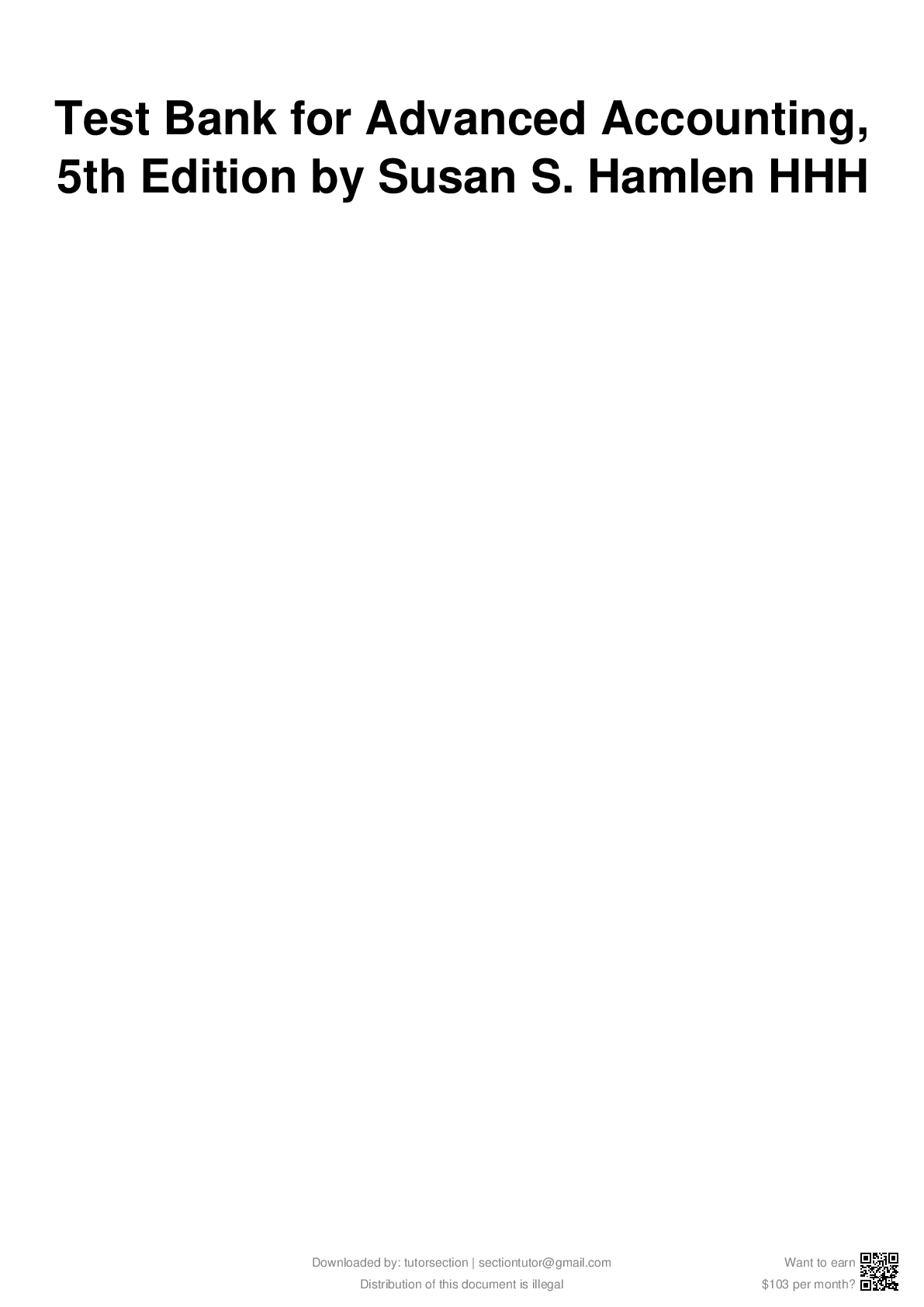
Reviews( 0 )
Document information
Connected school, study & course
About the document
Uploaded On
Jul 14, 2022
Number of pages
248
Written in
Additional information
This document has been written for:
Uploaded
Jul 14, 2022
Downloads
0
Views
108



